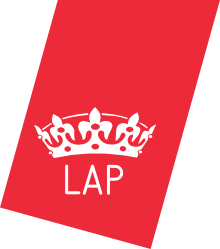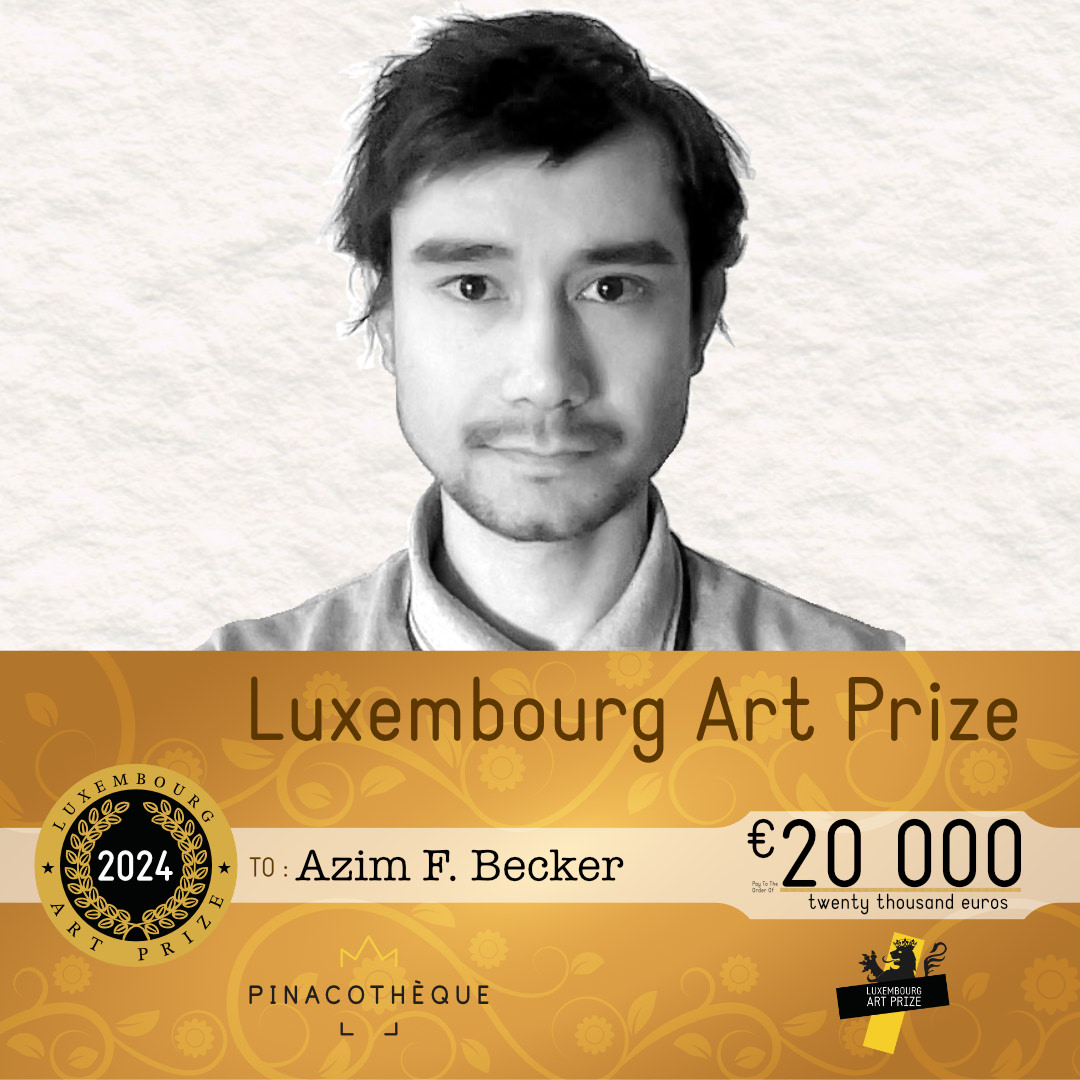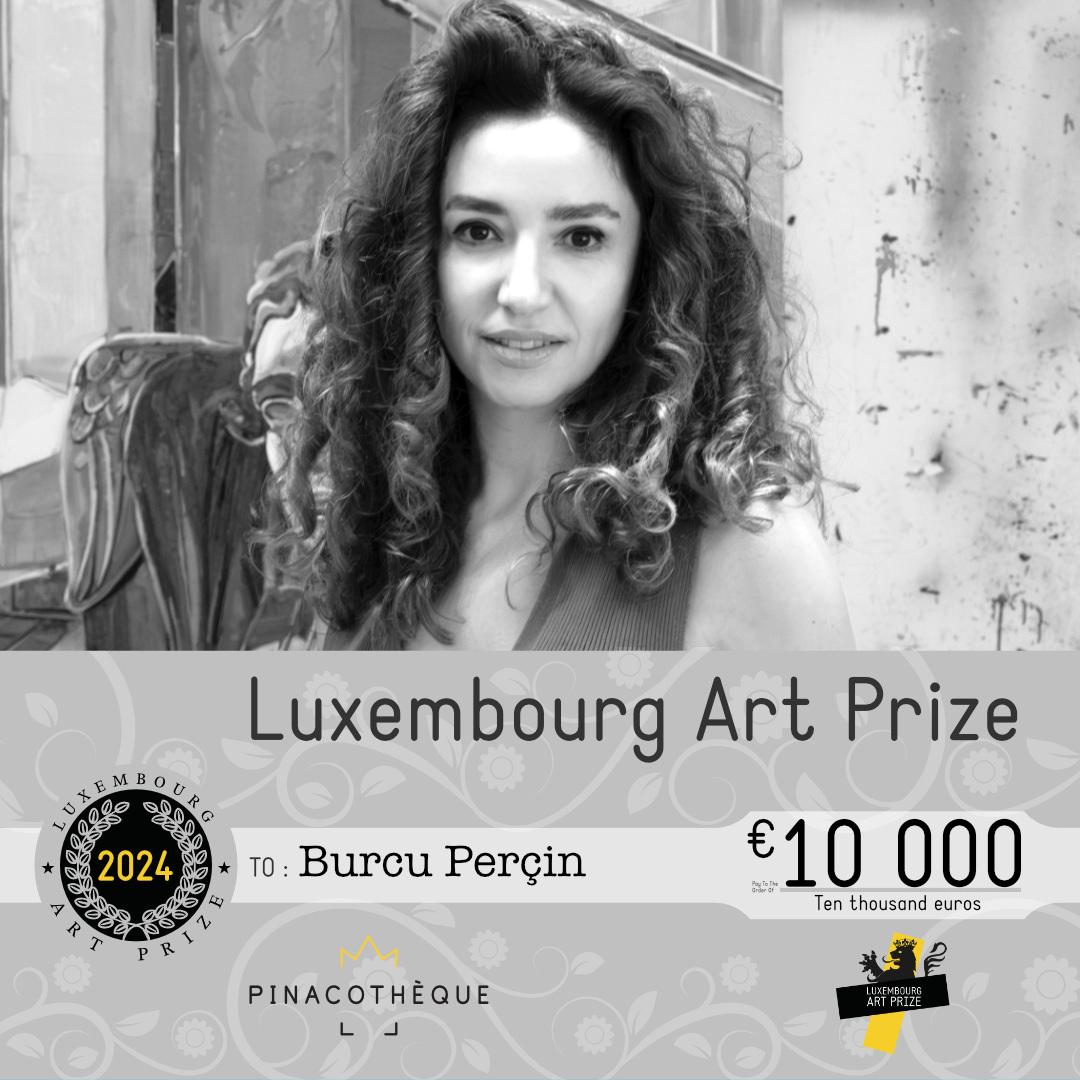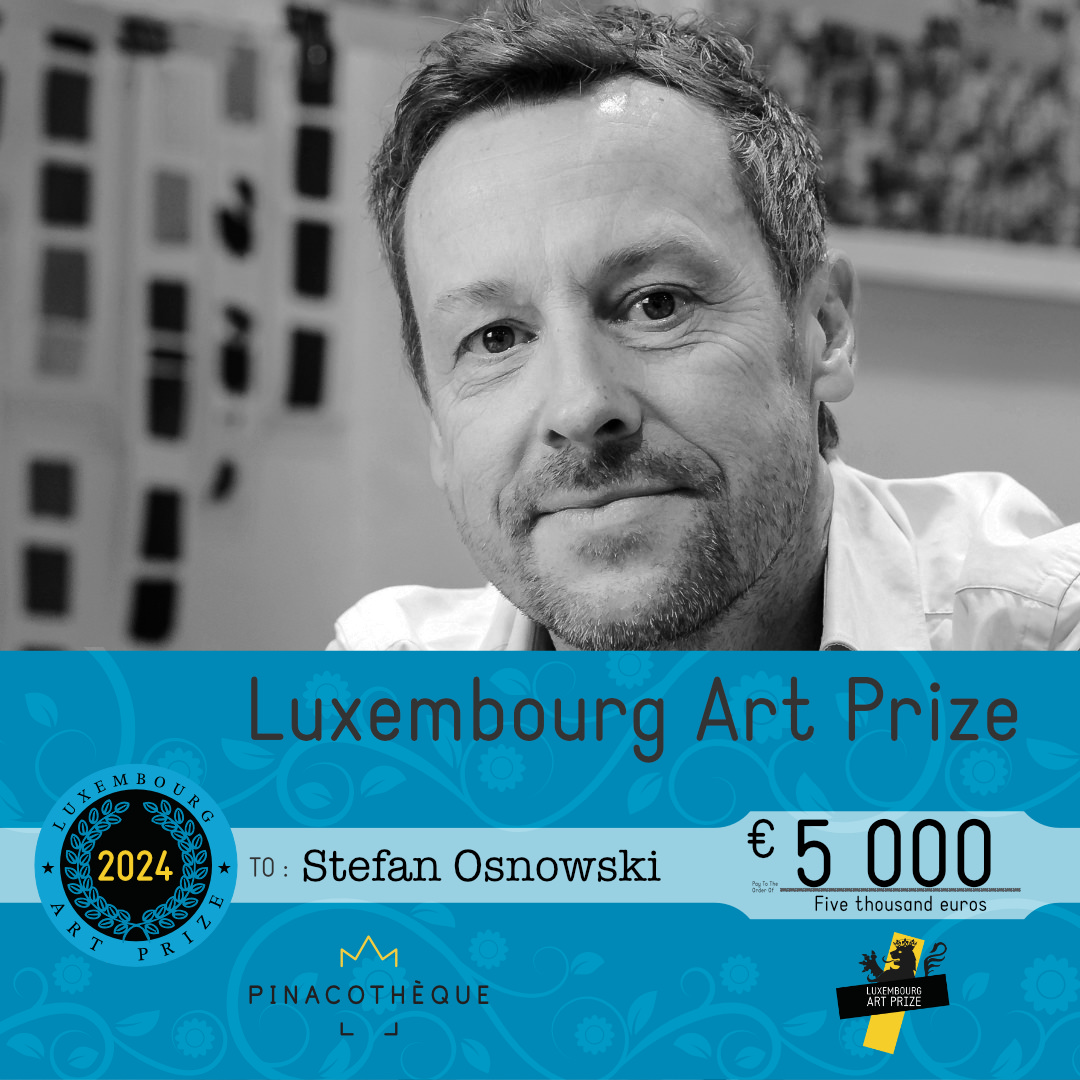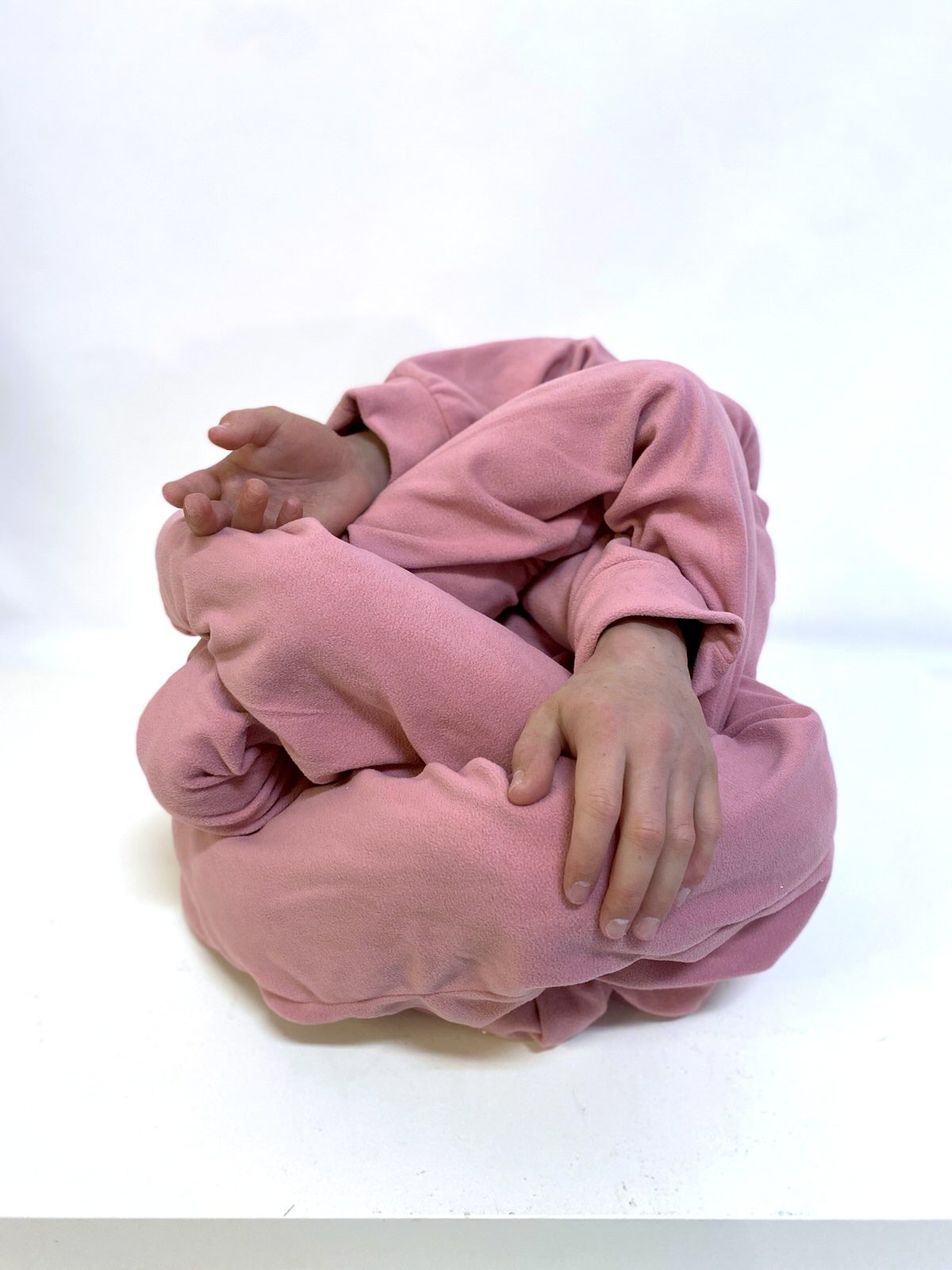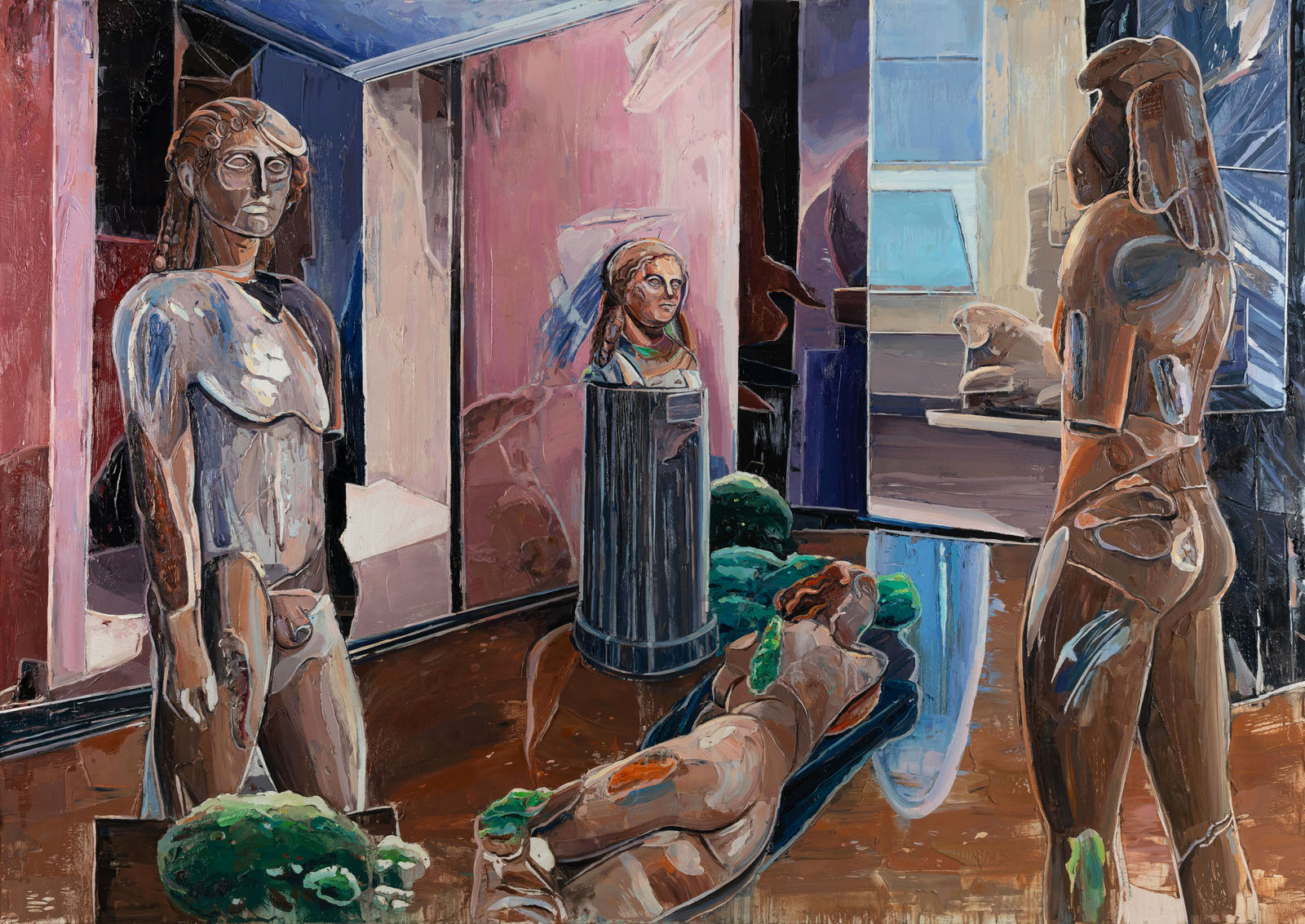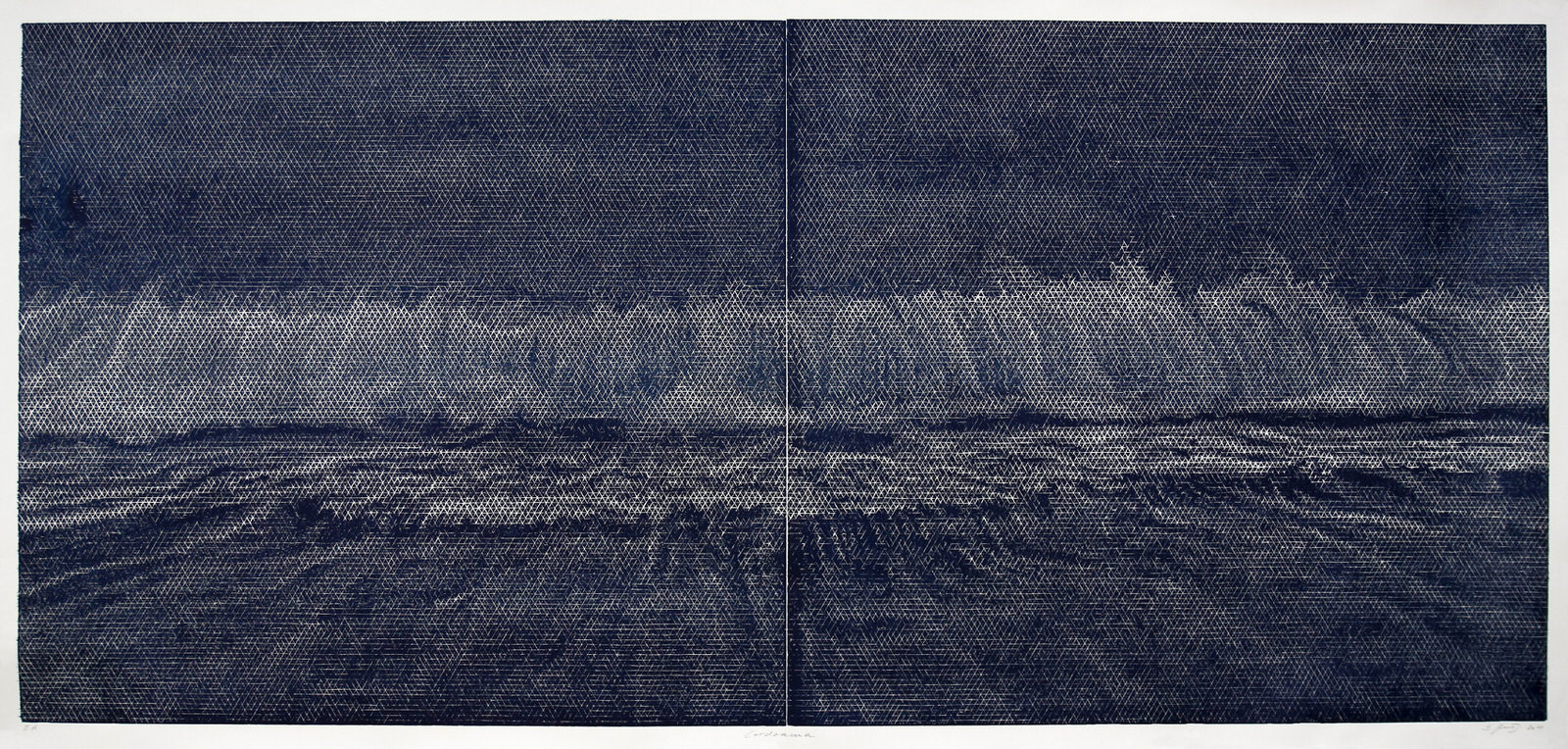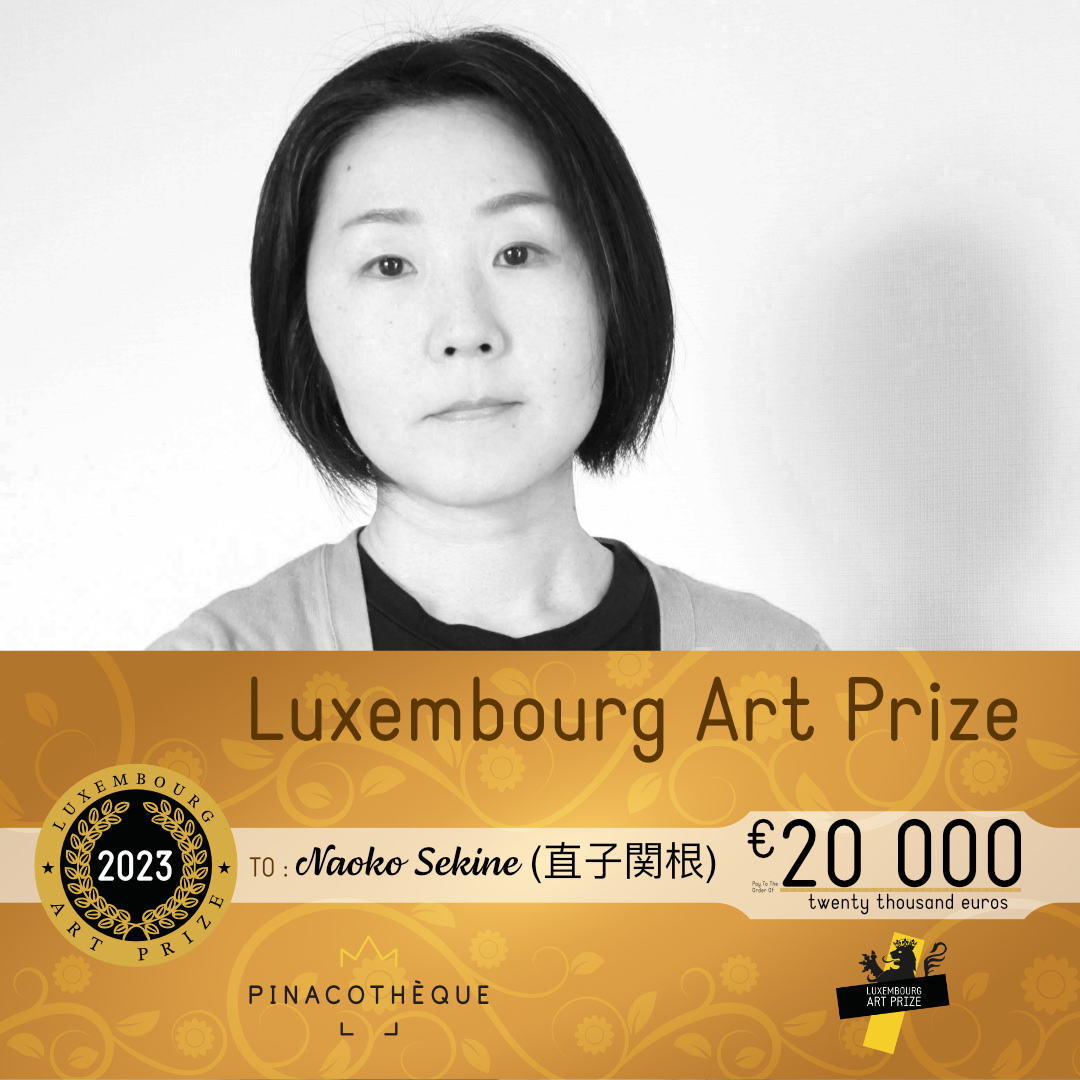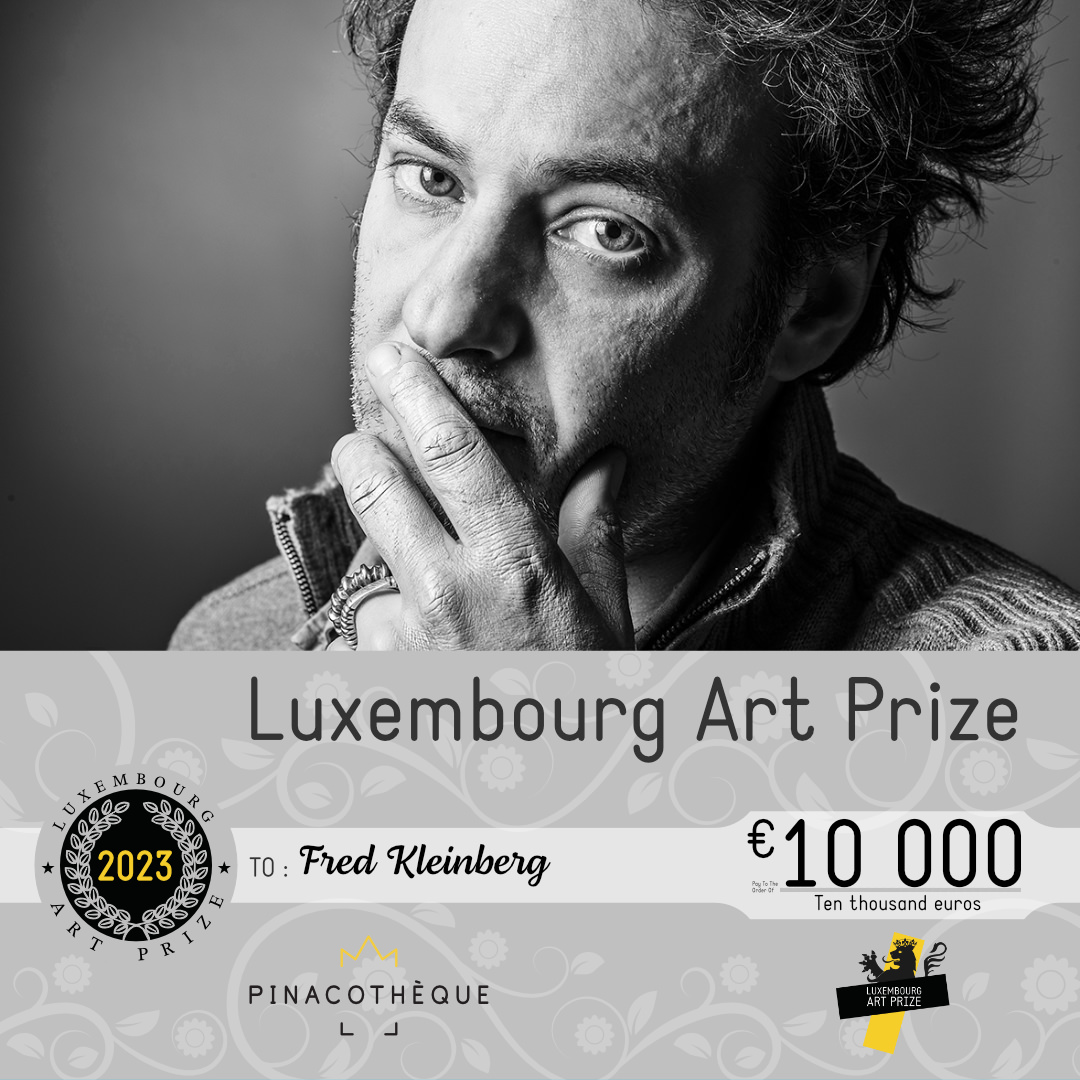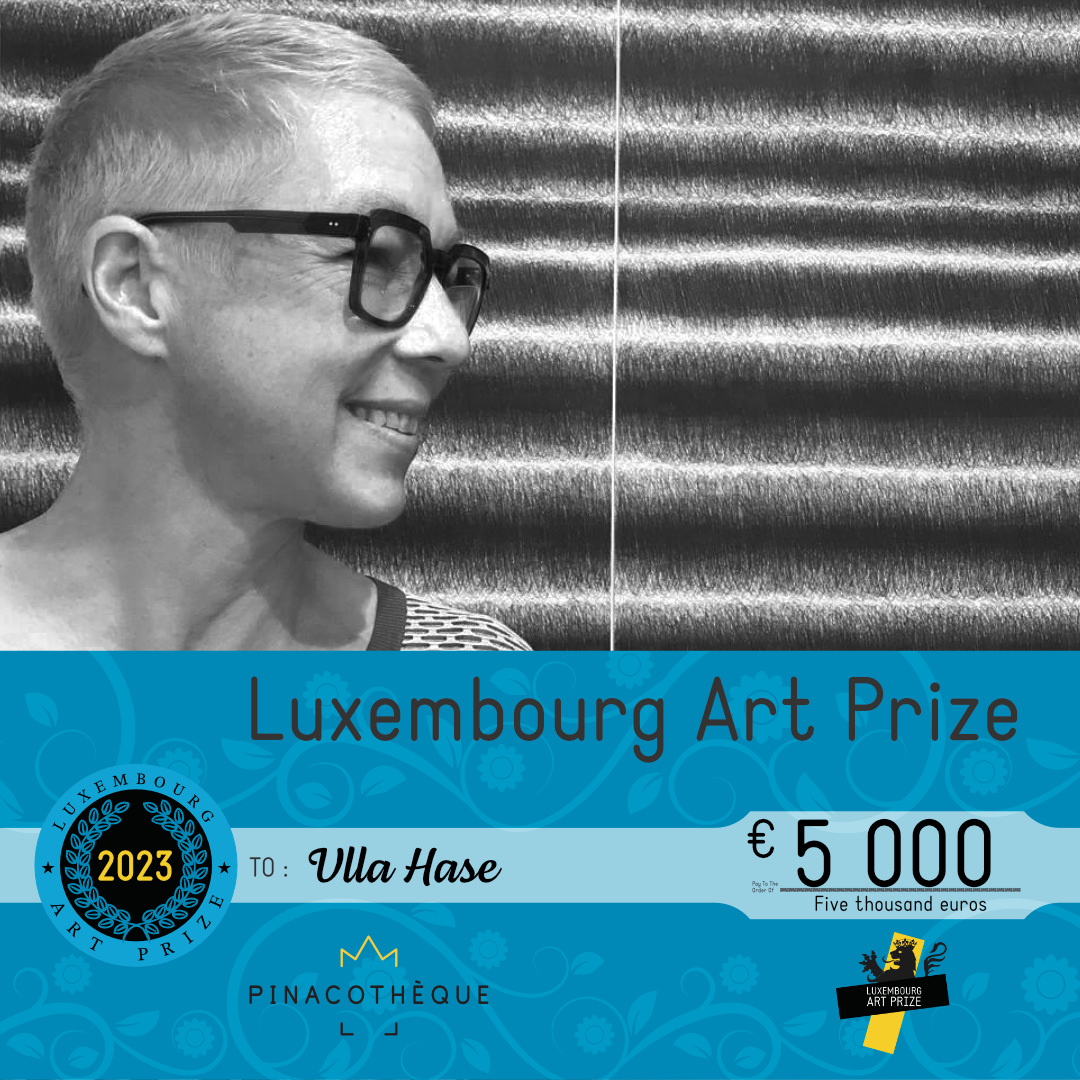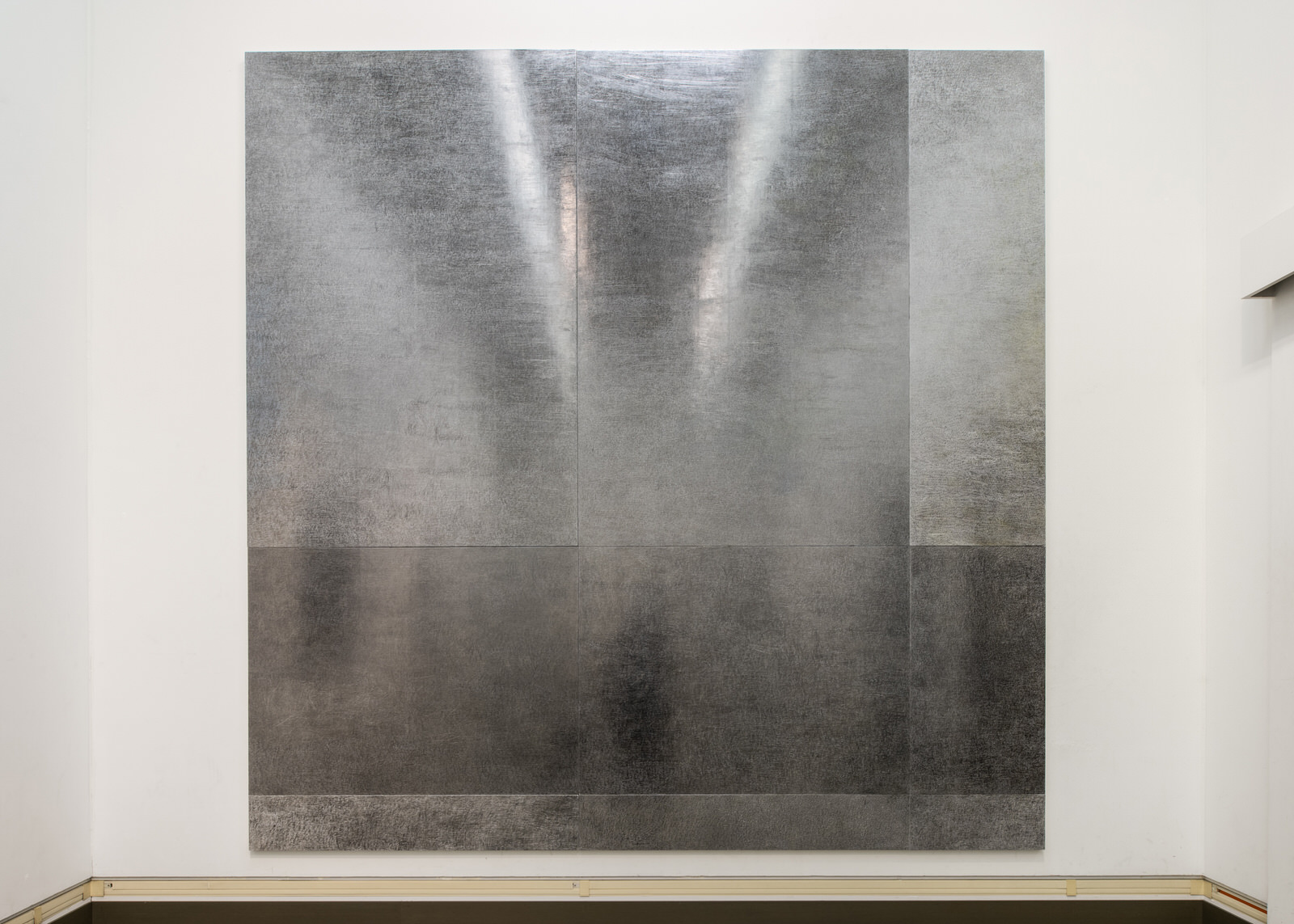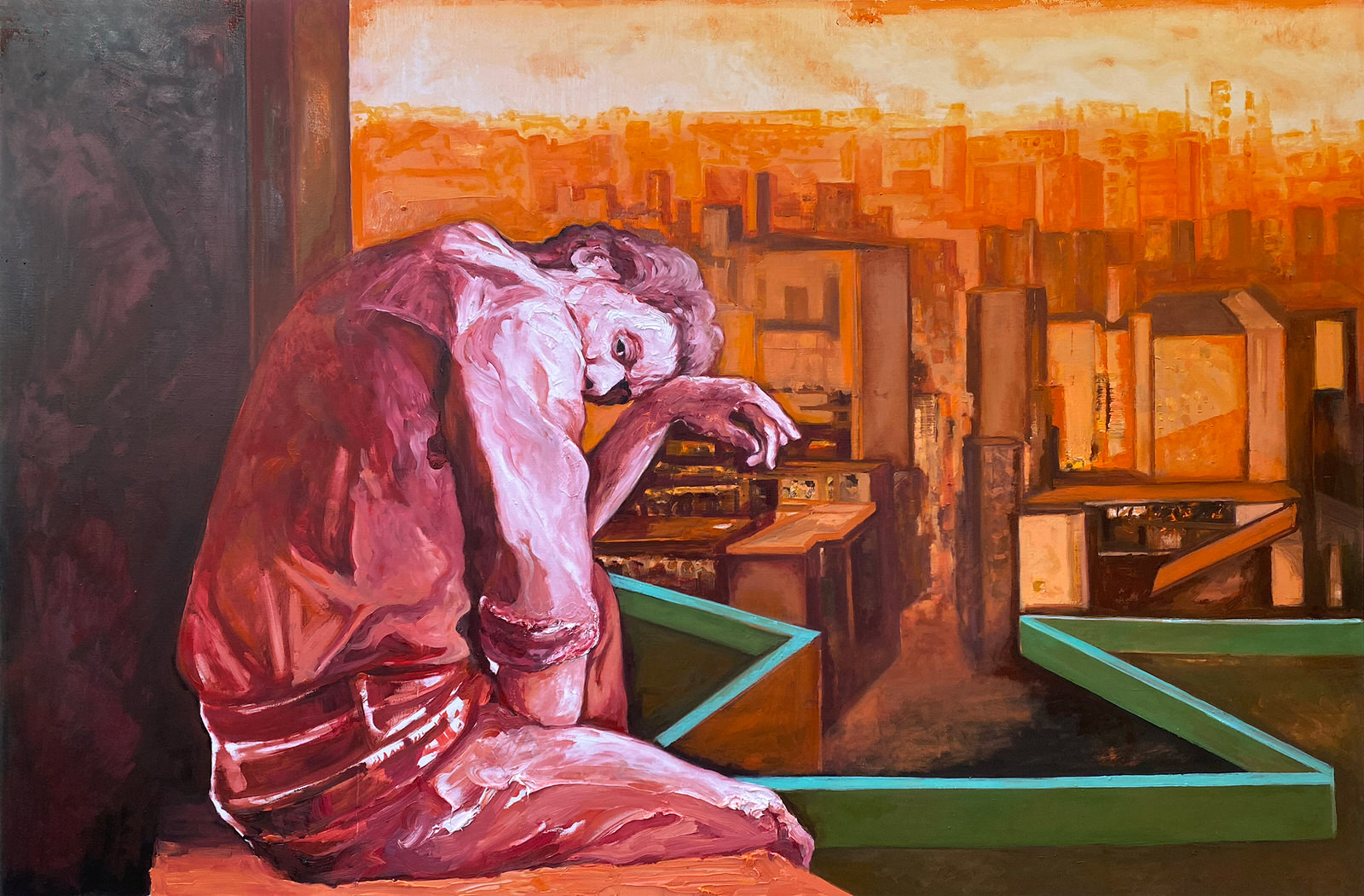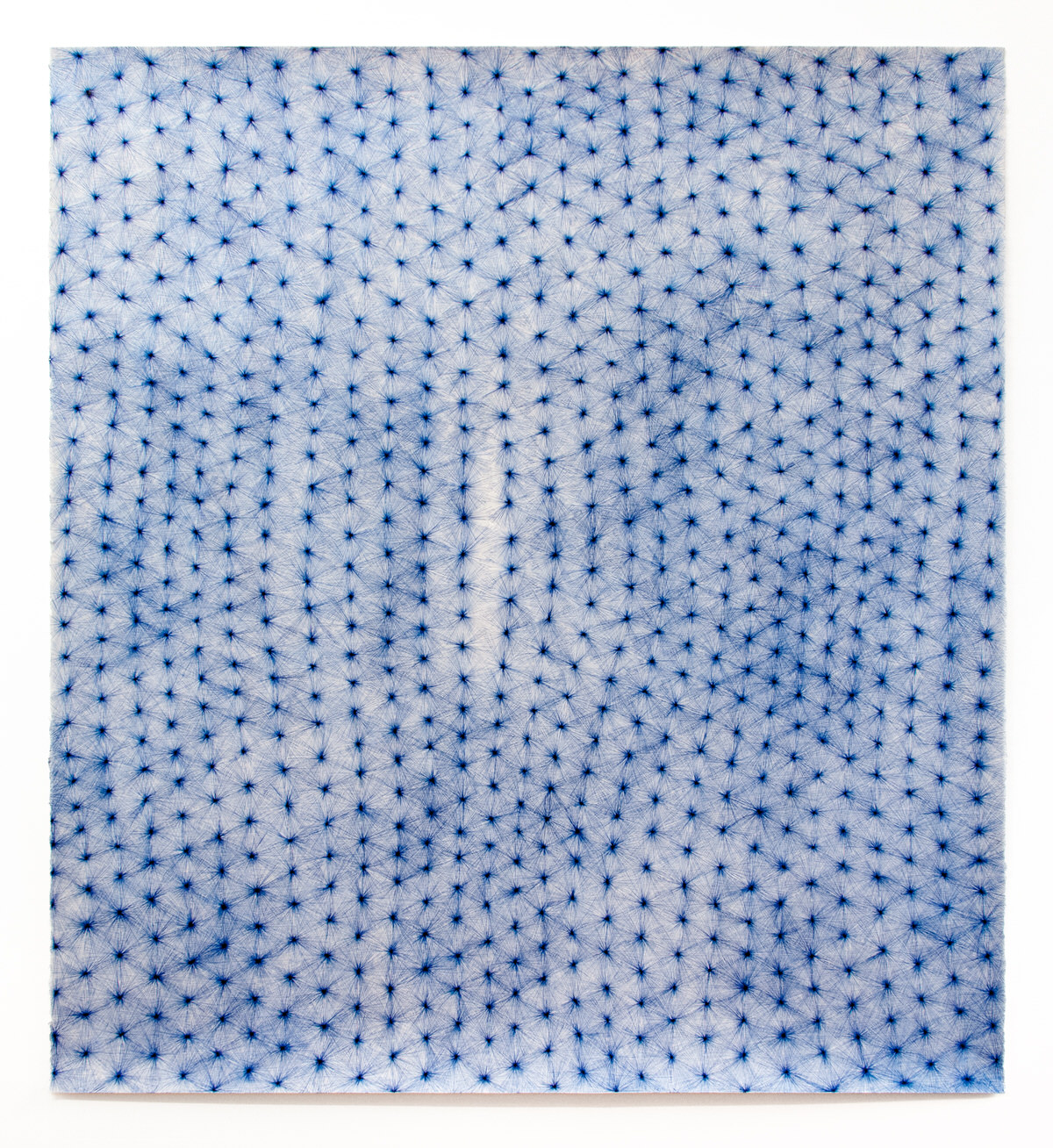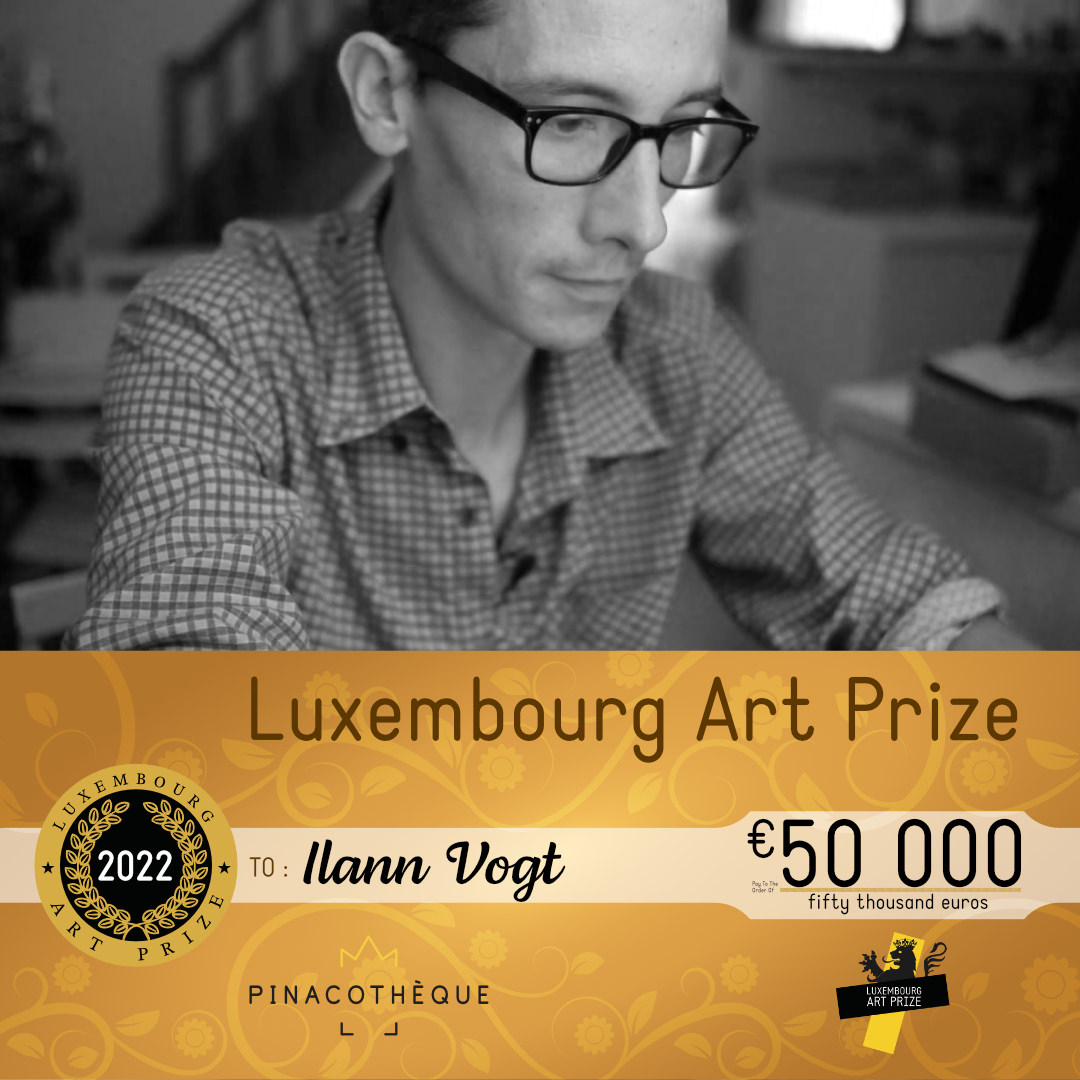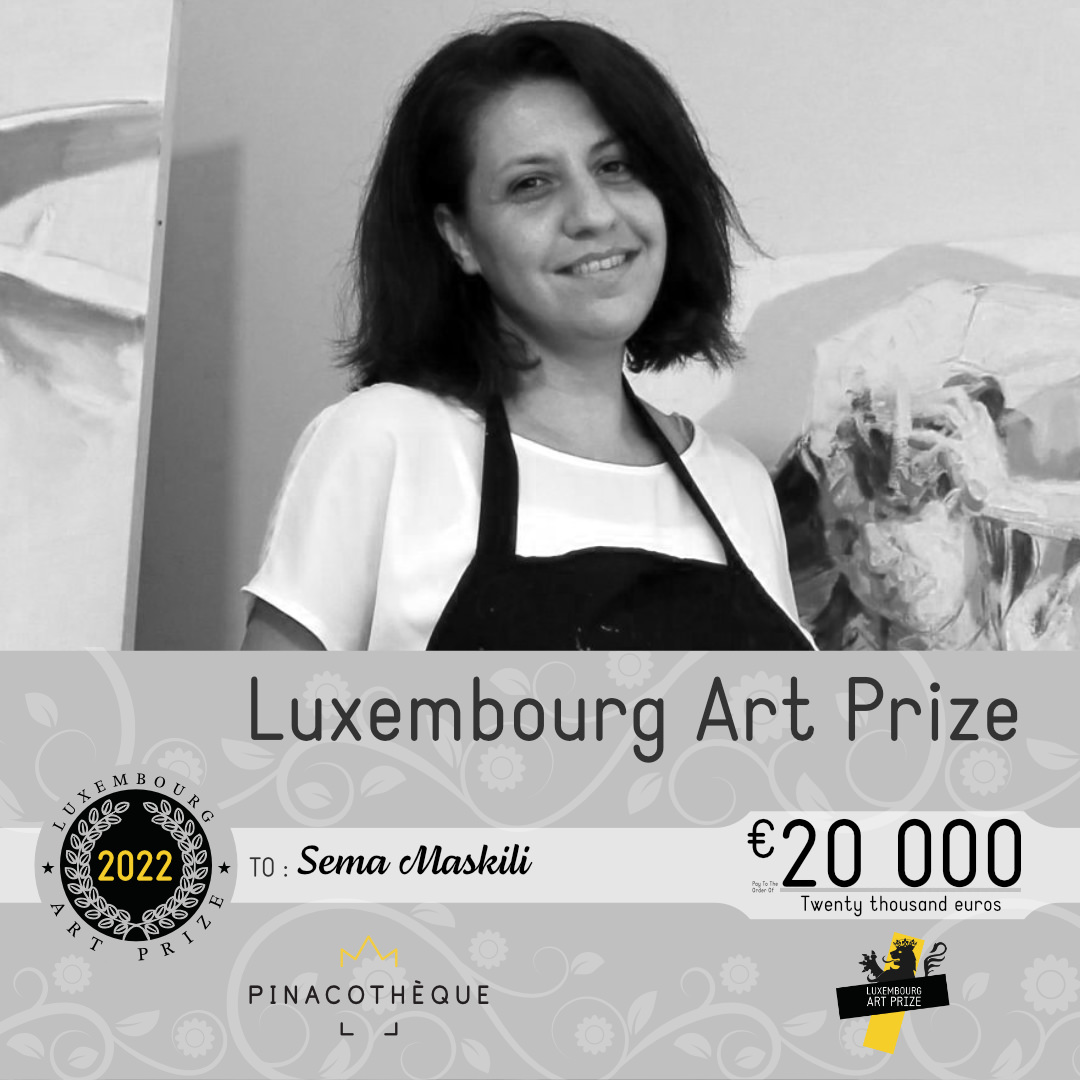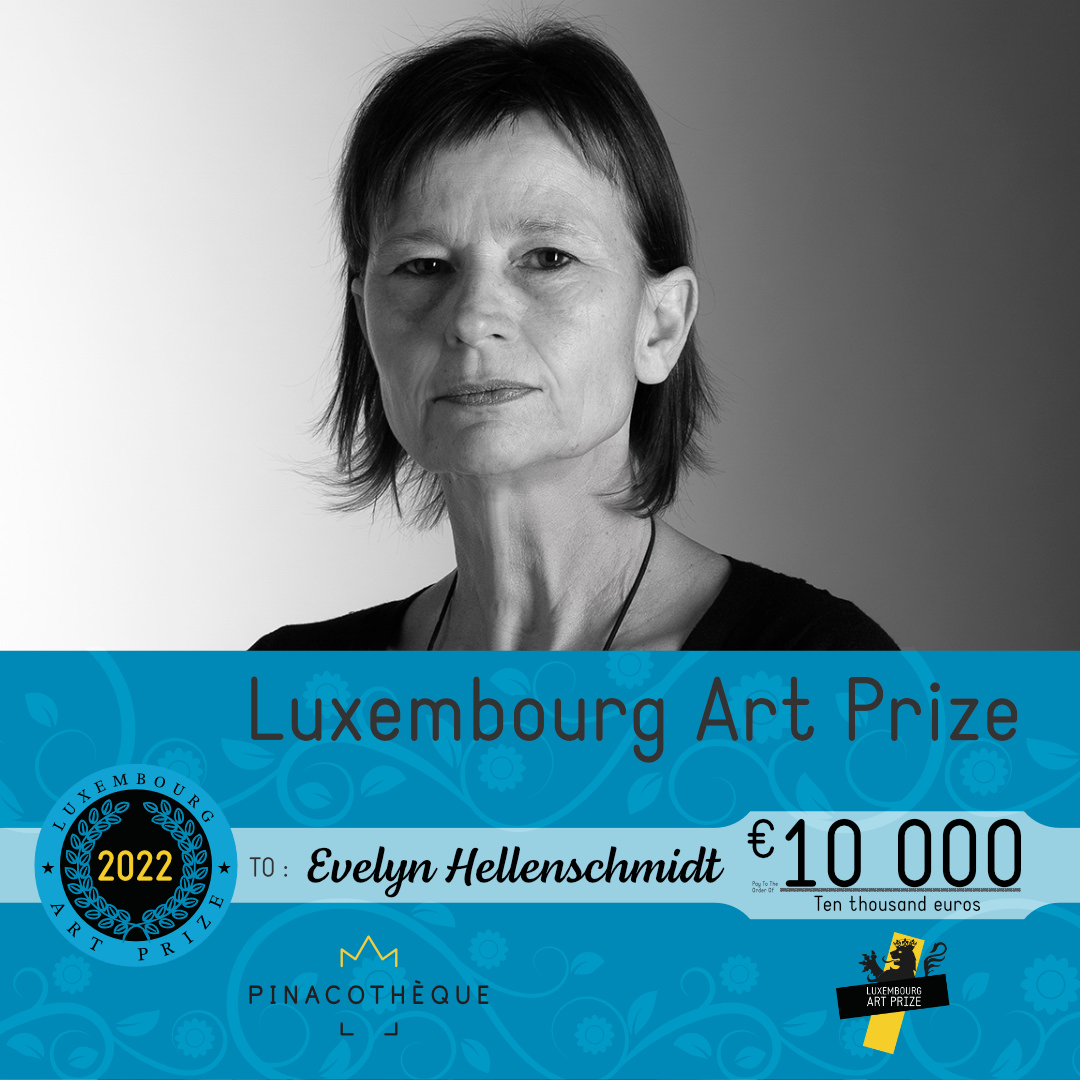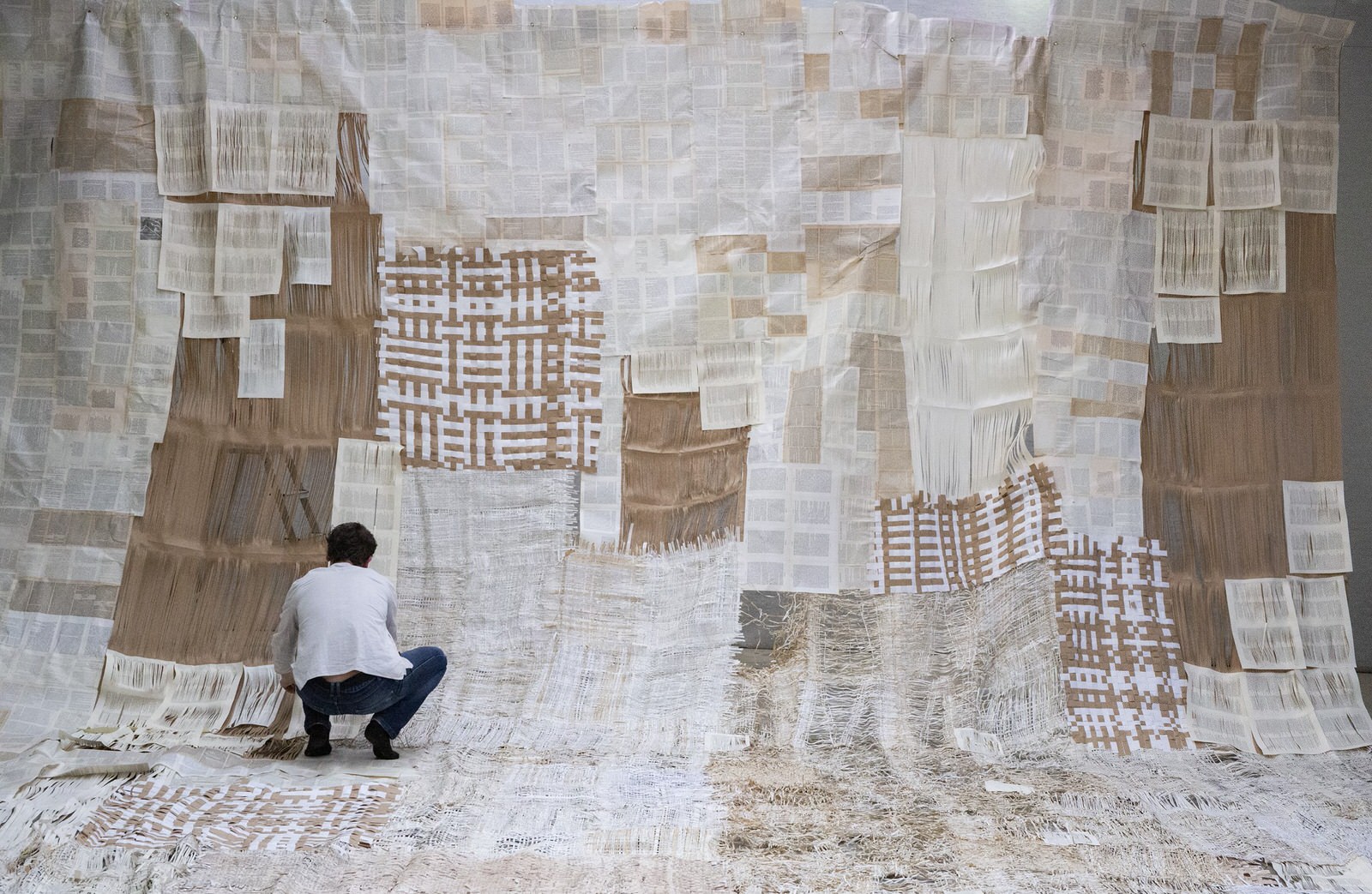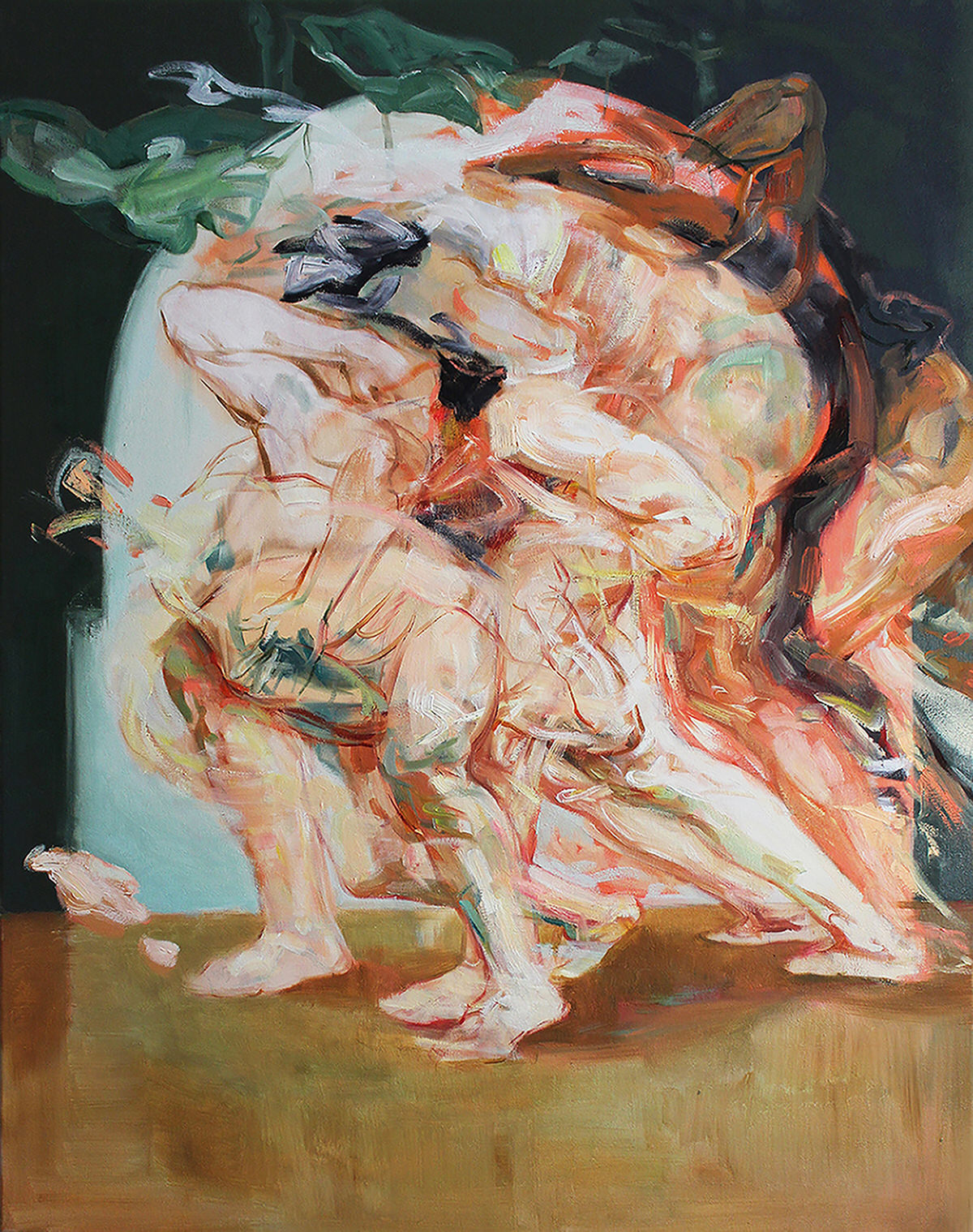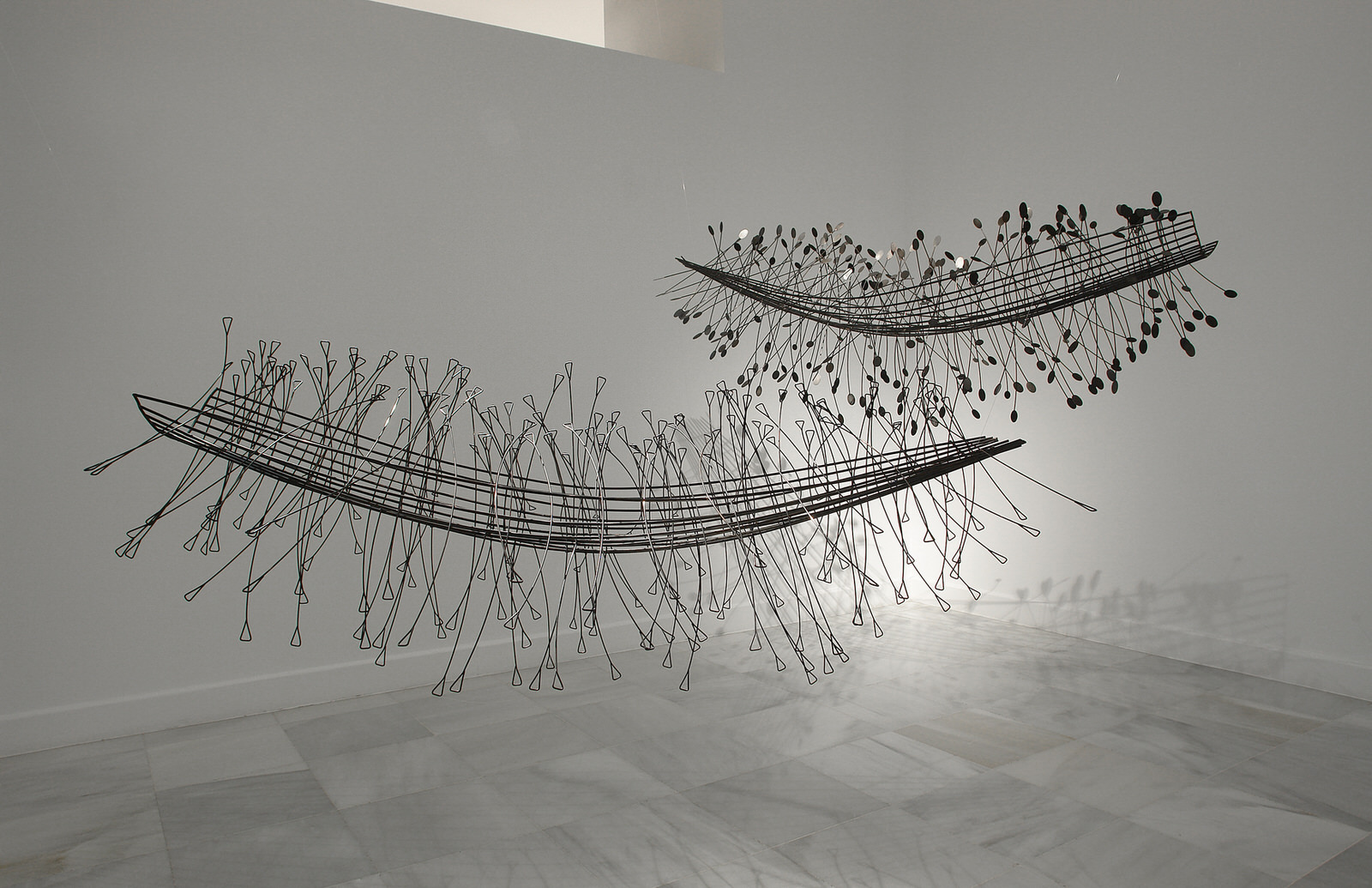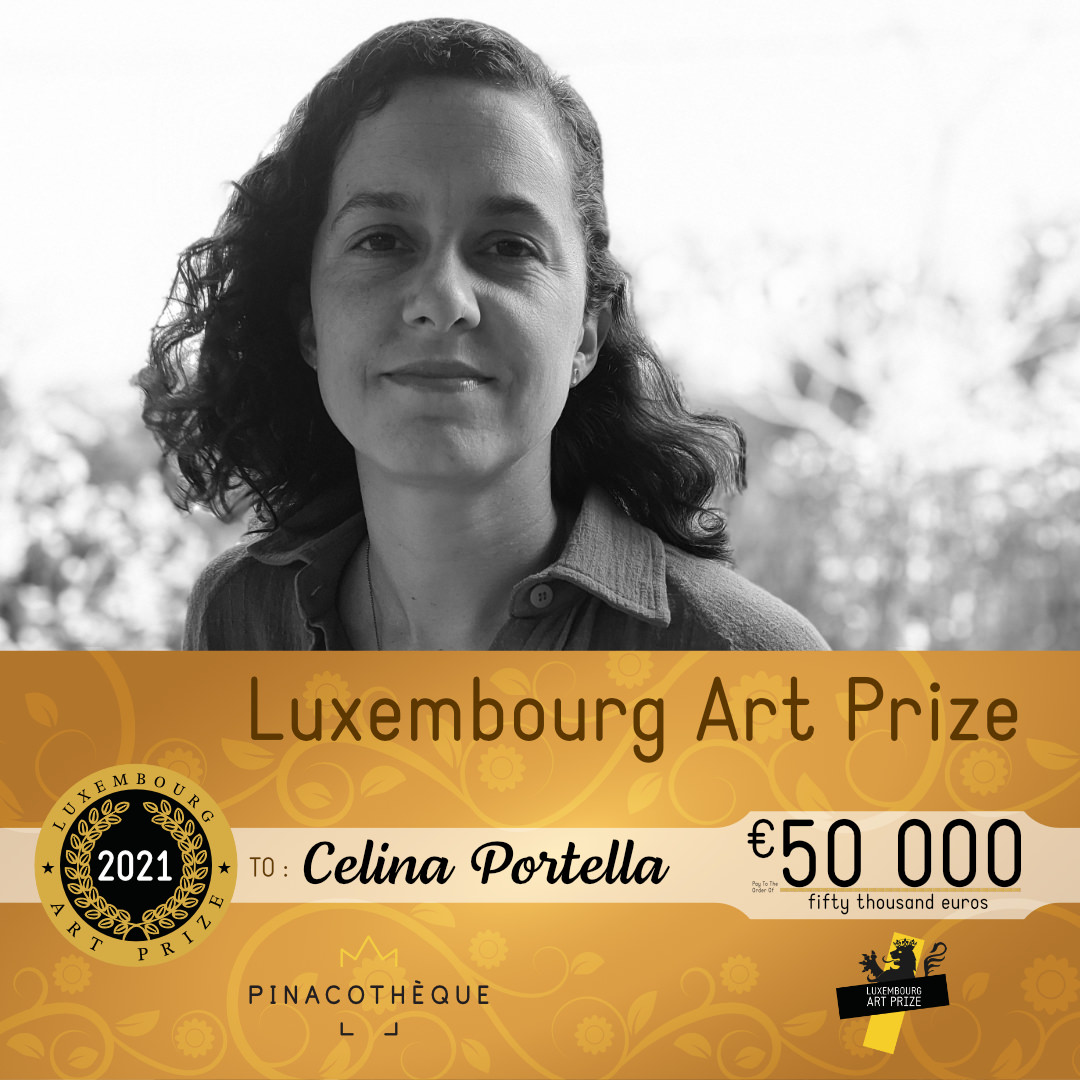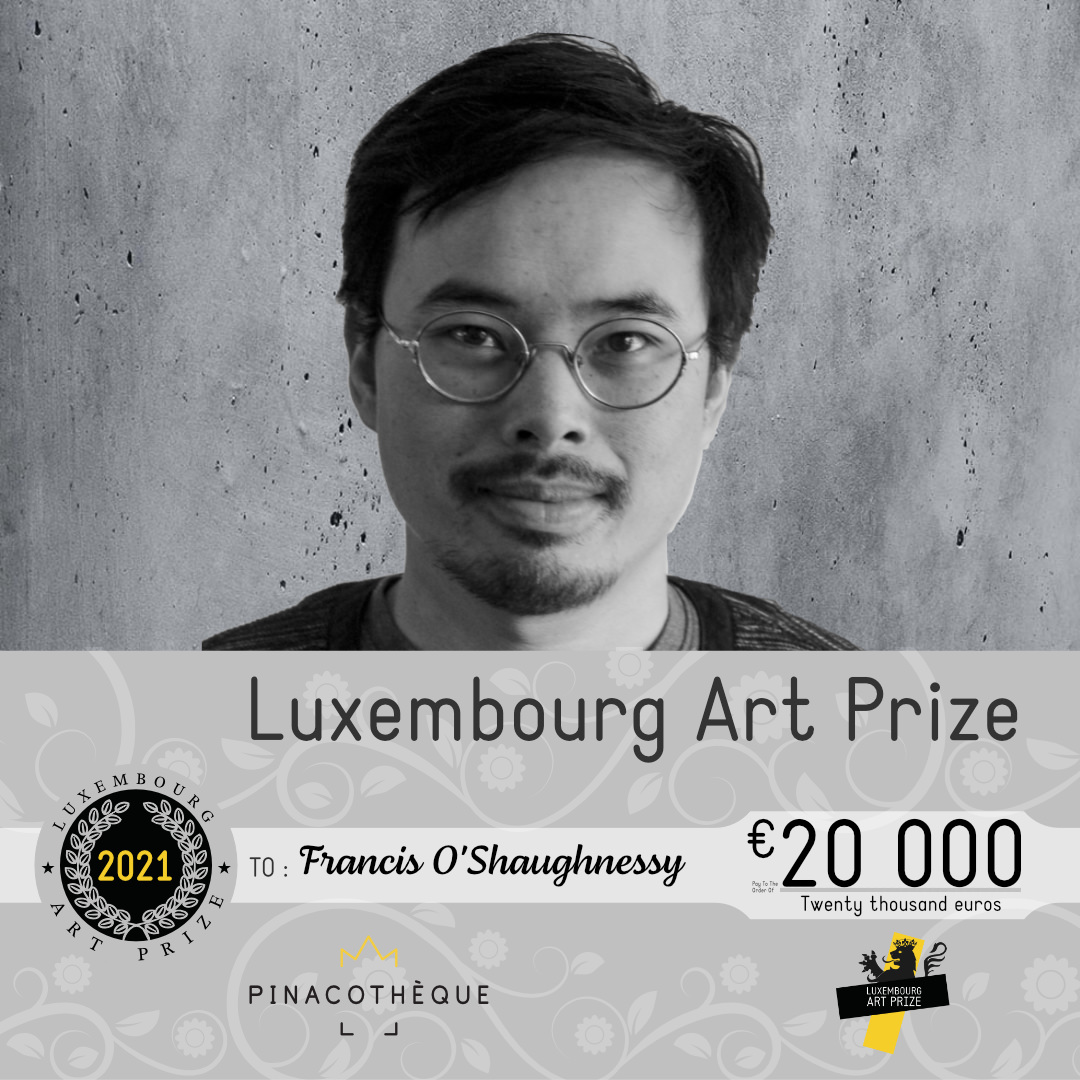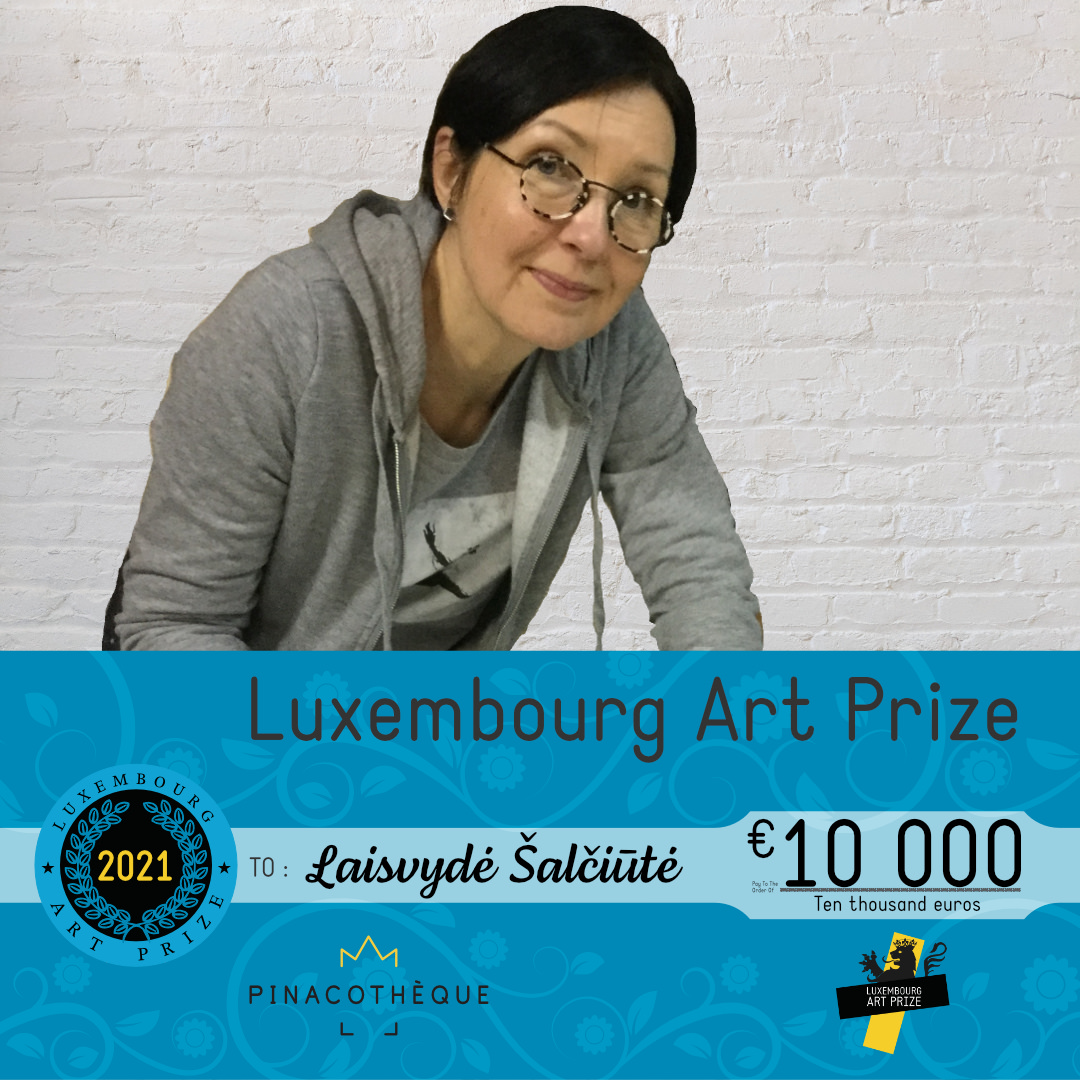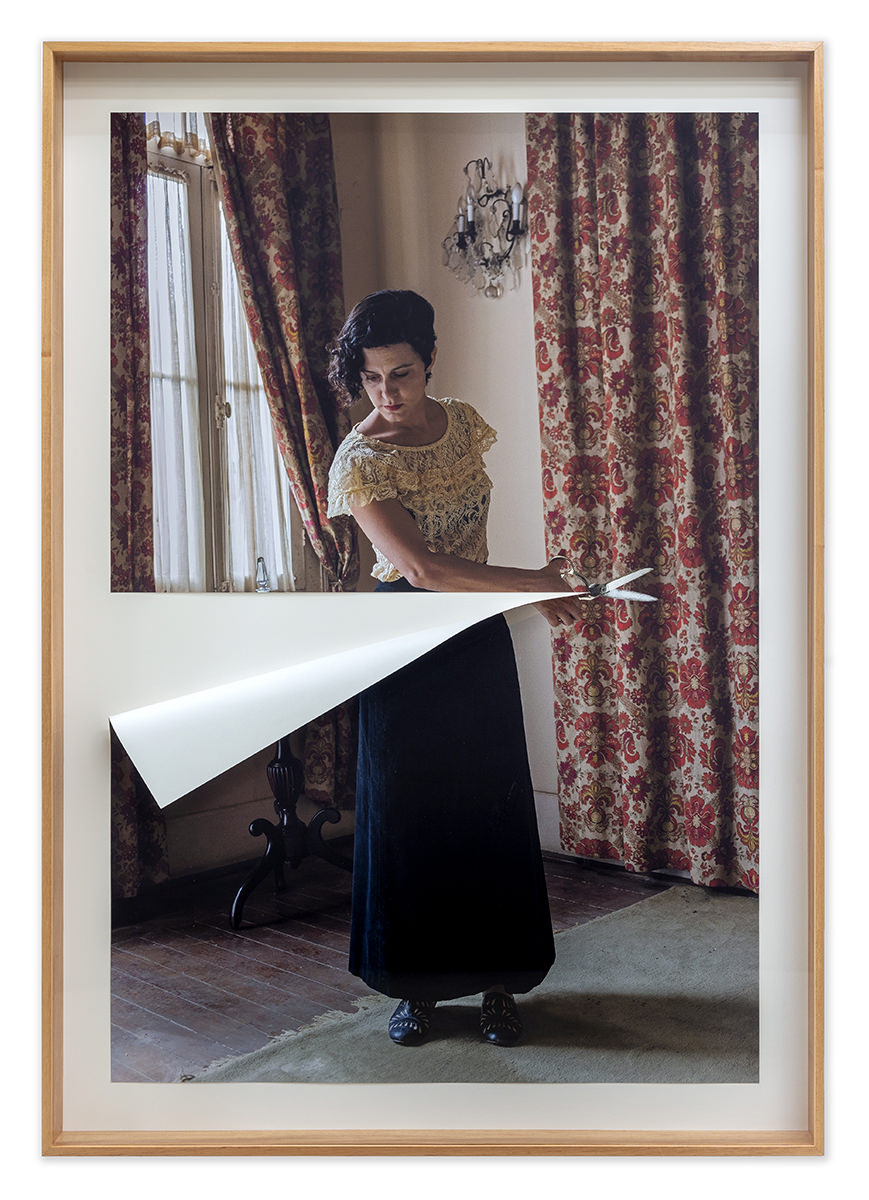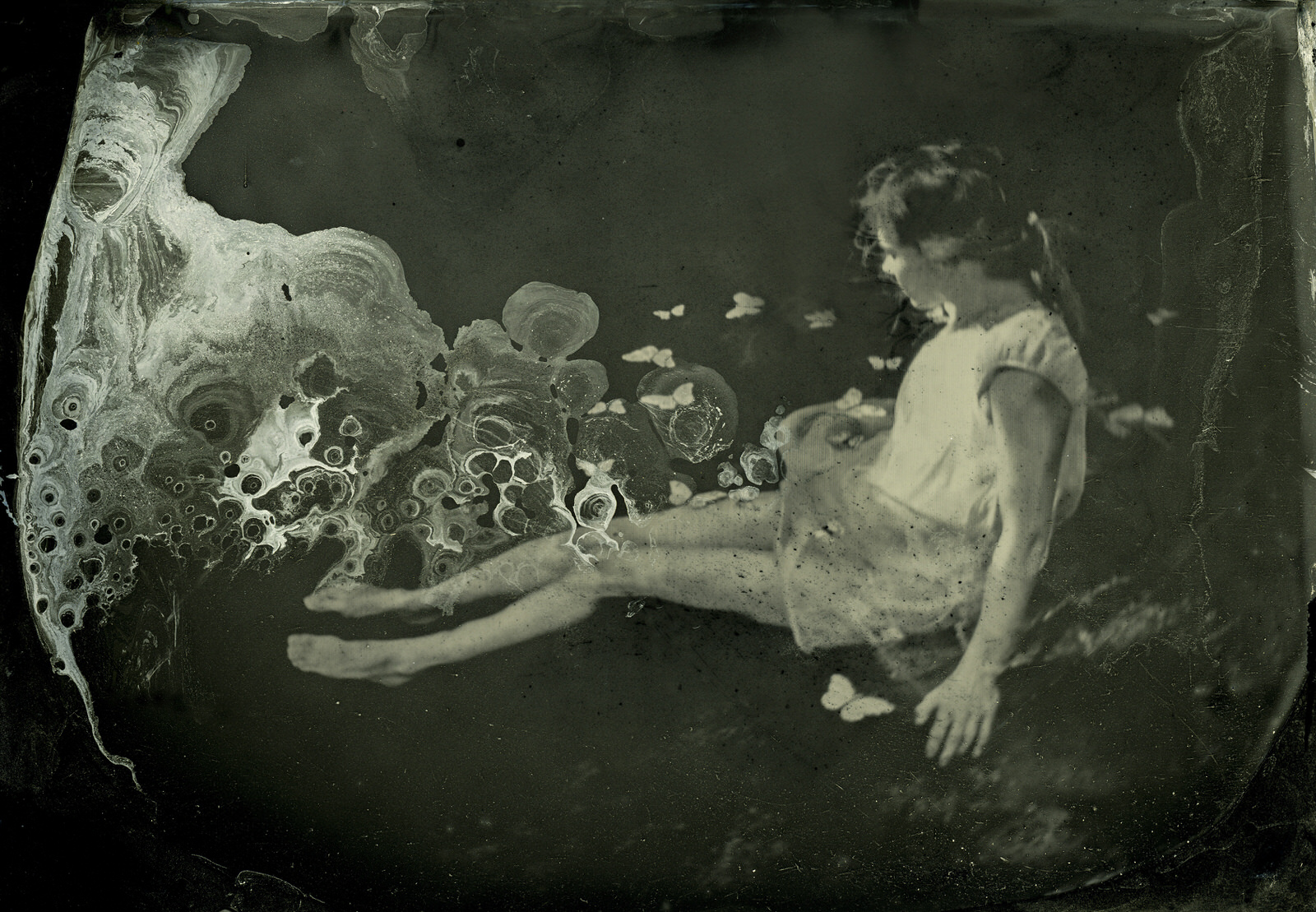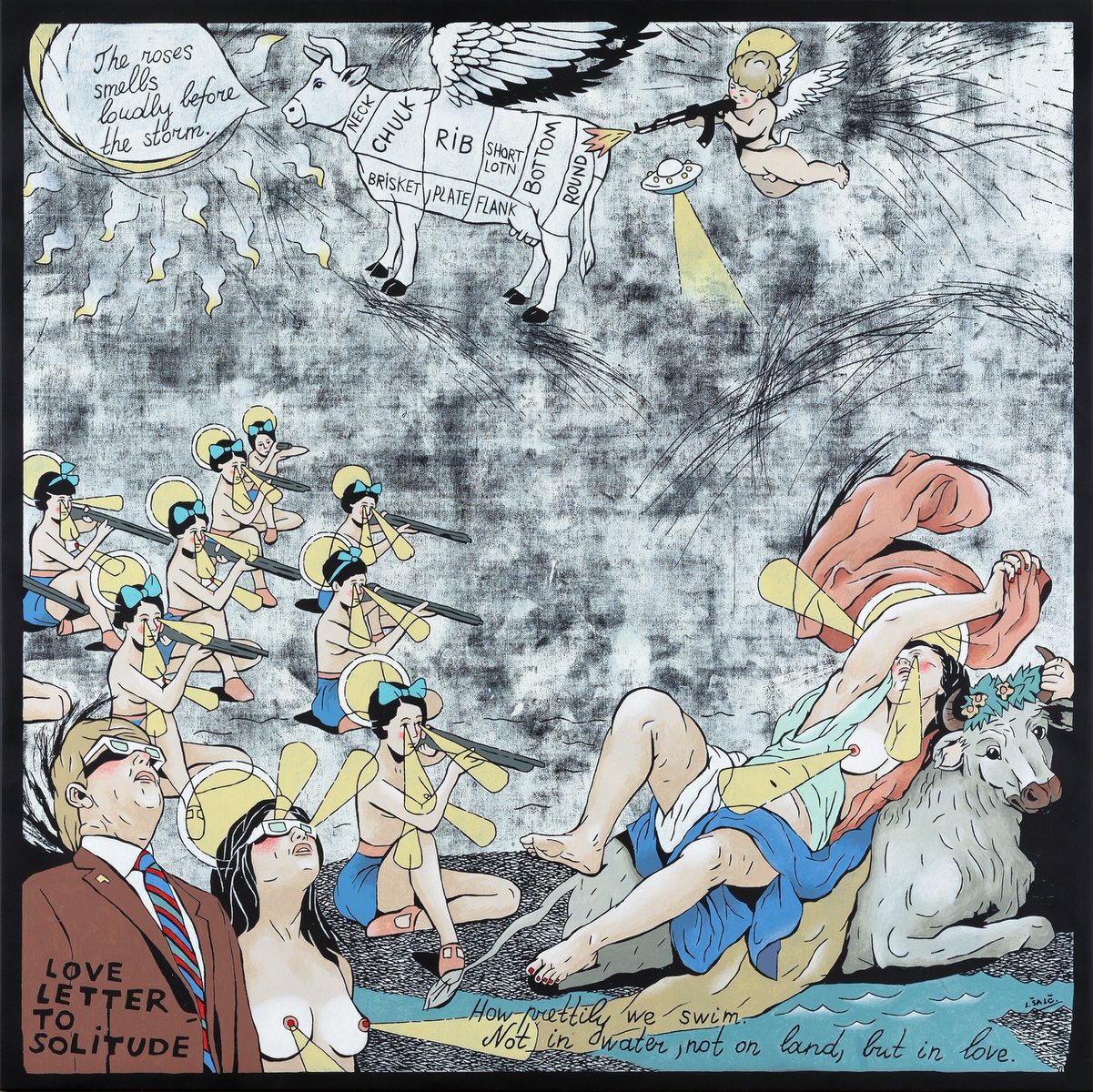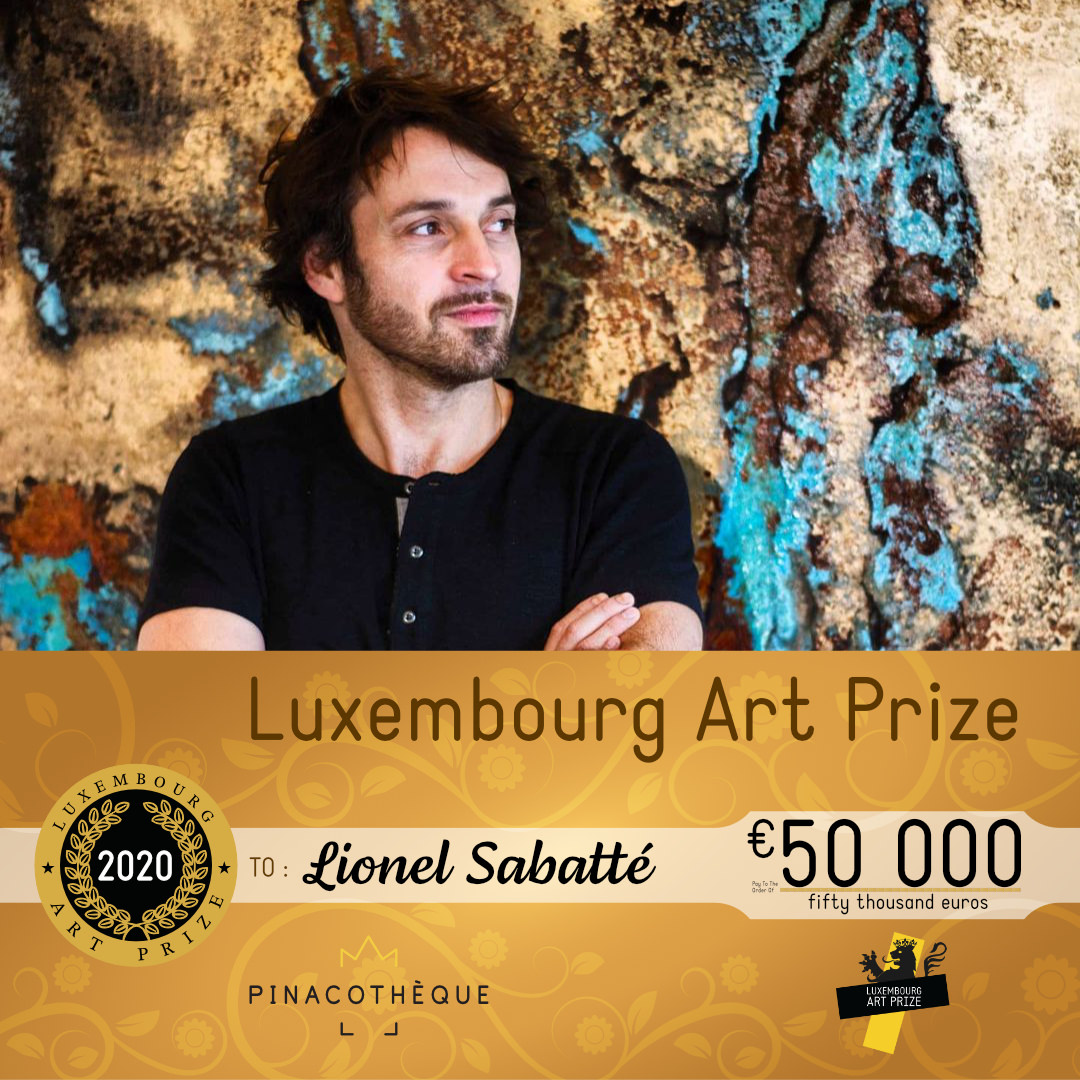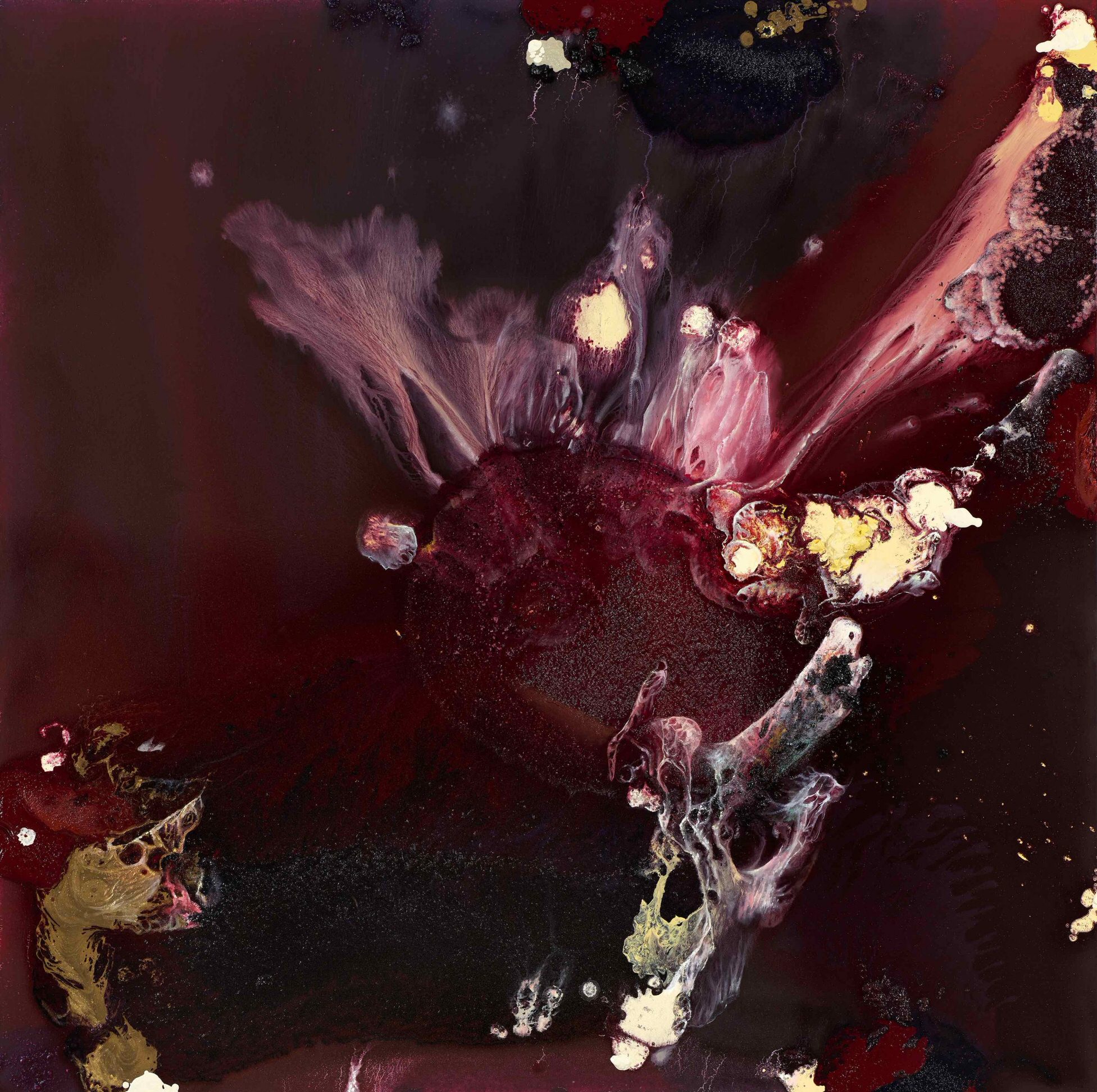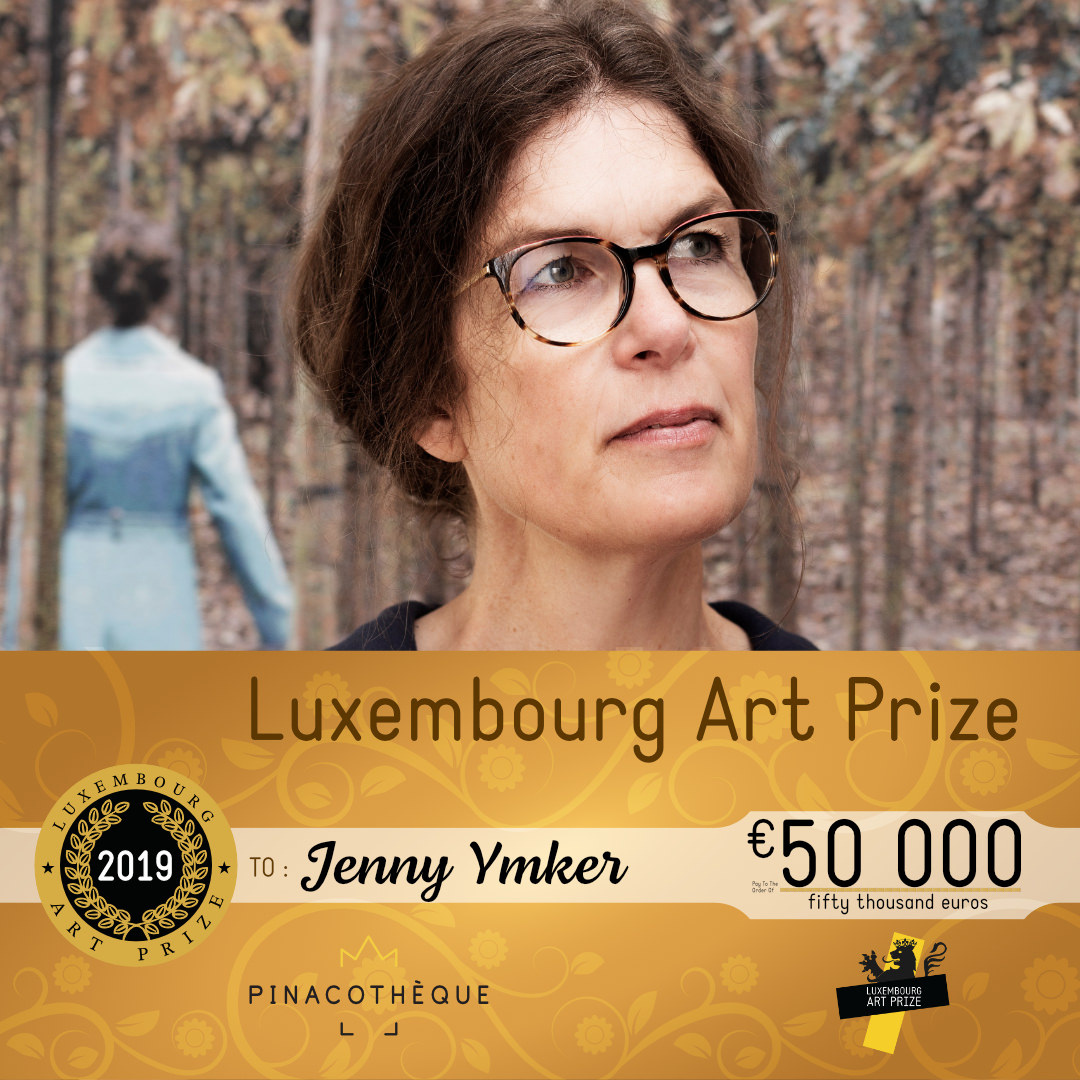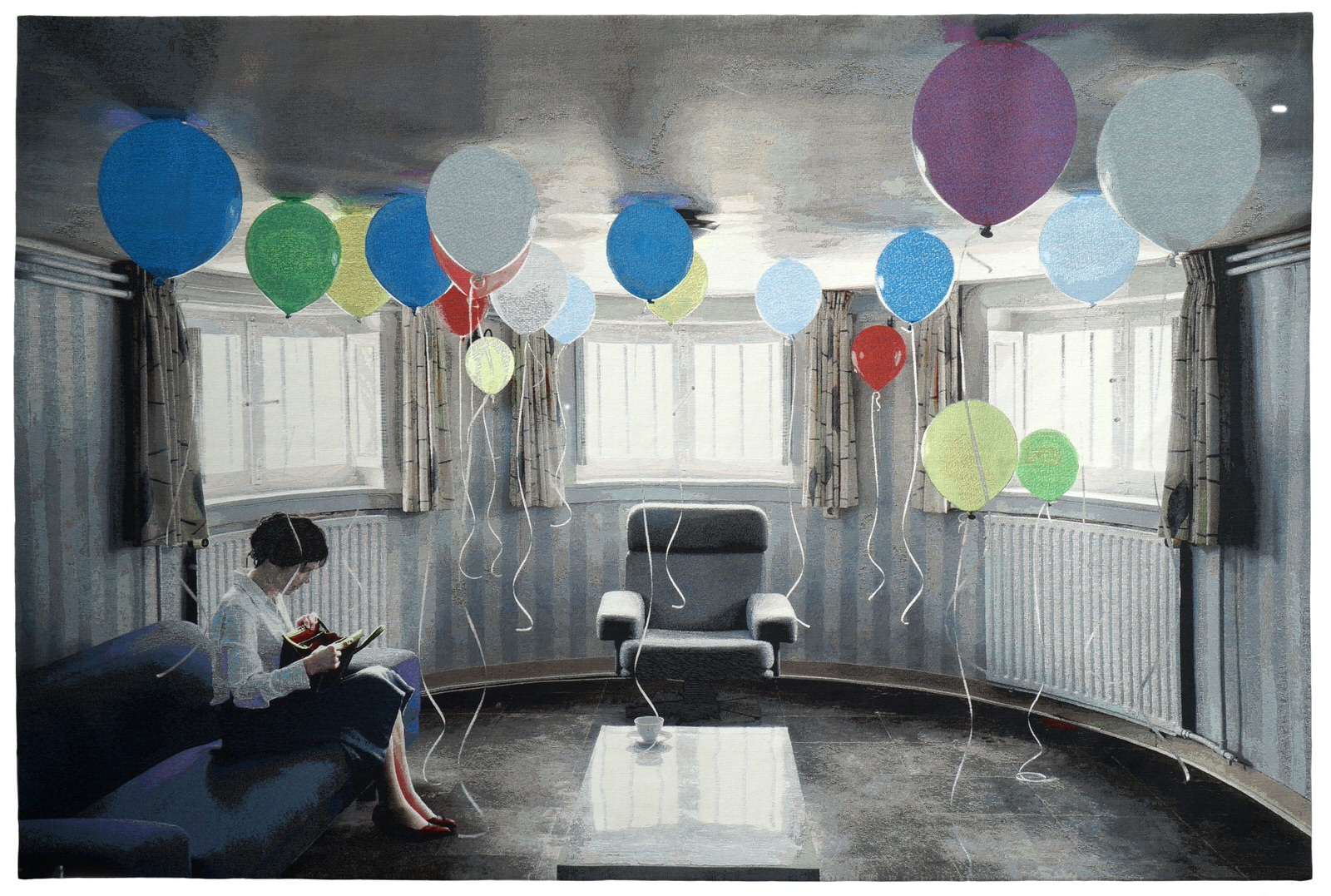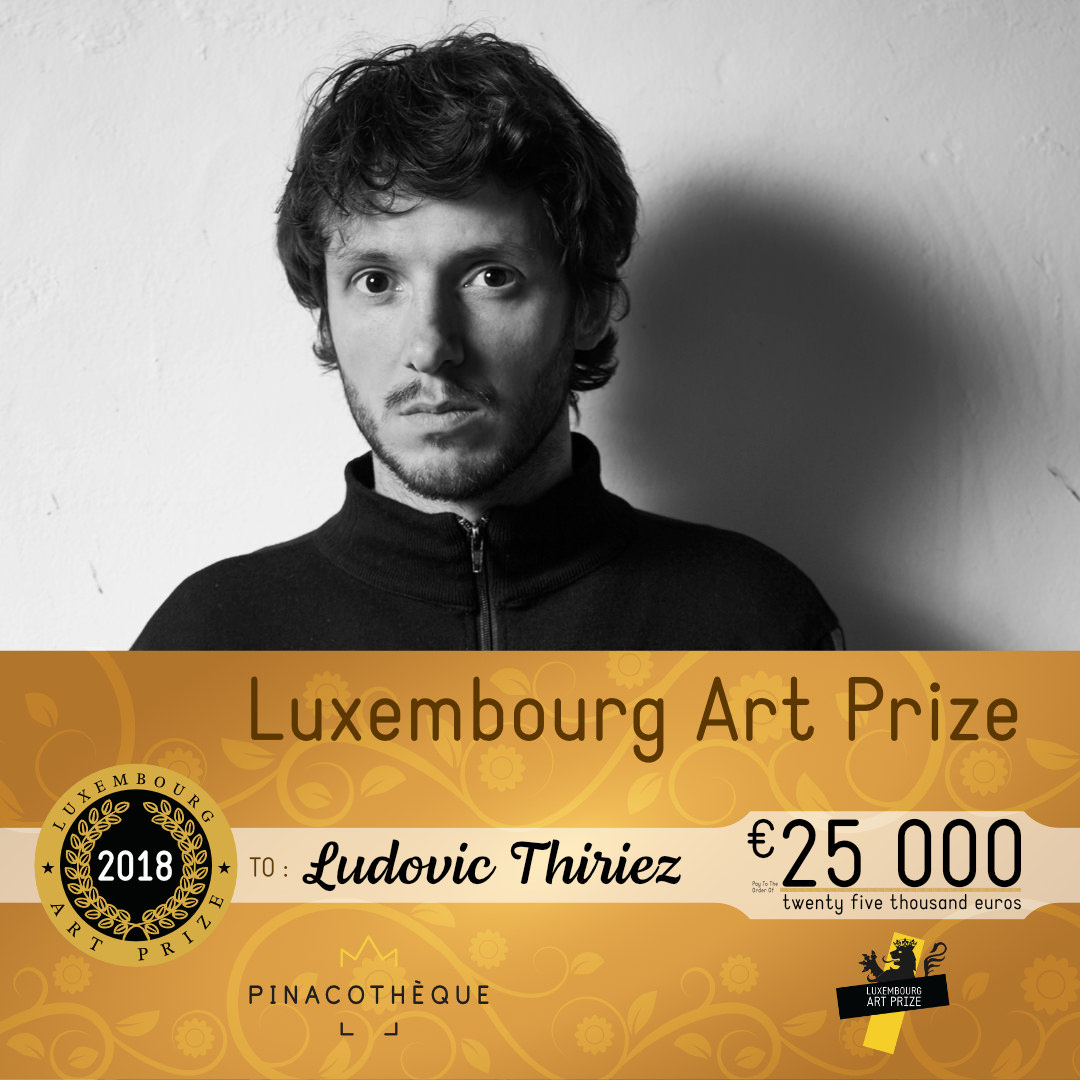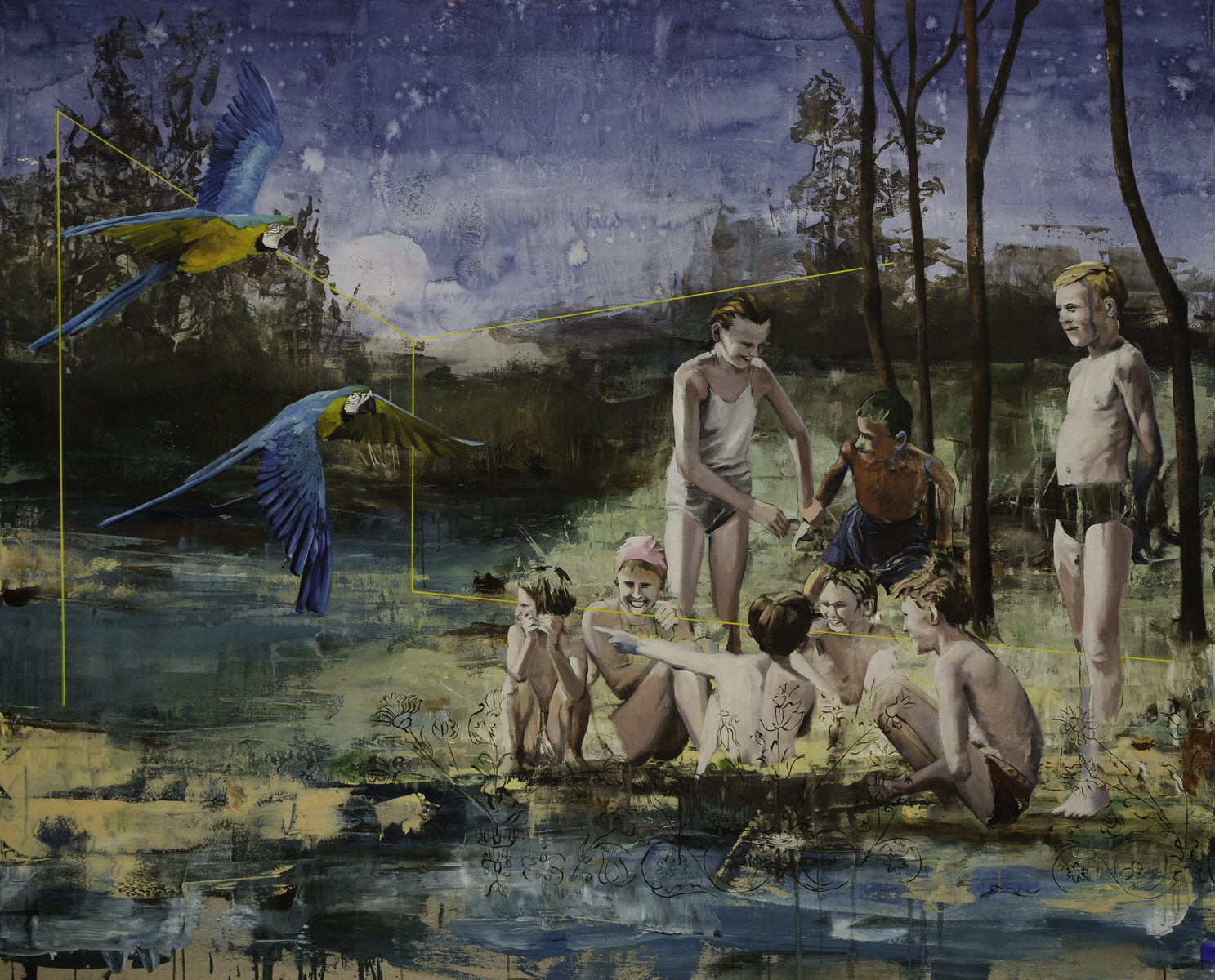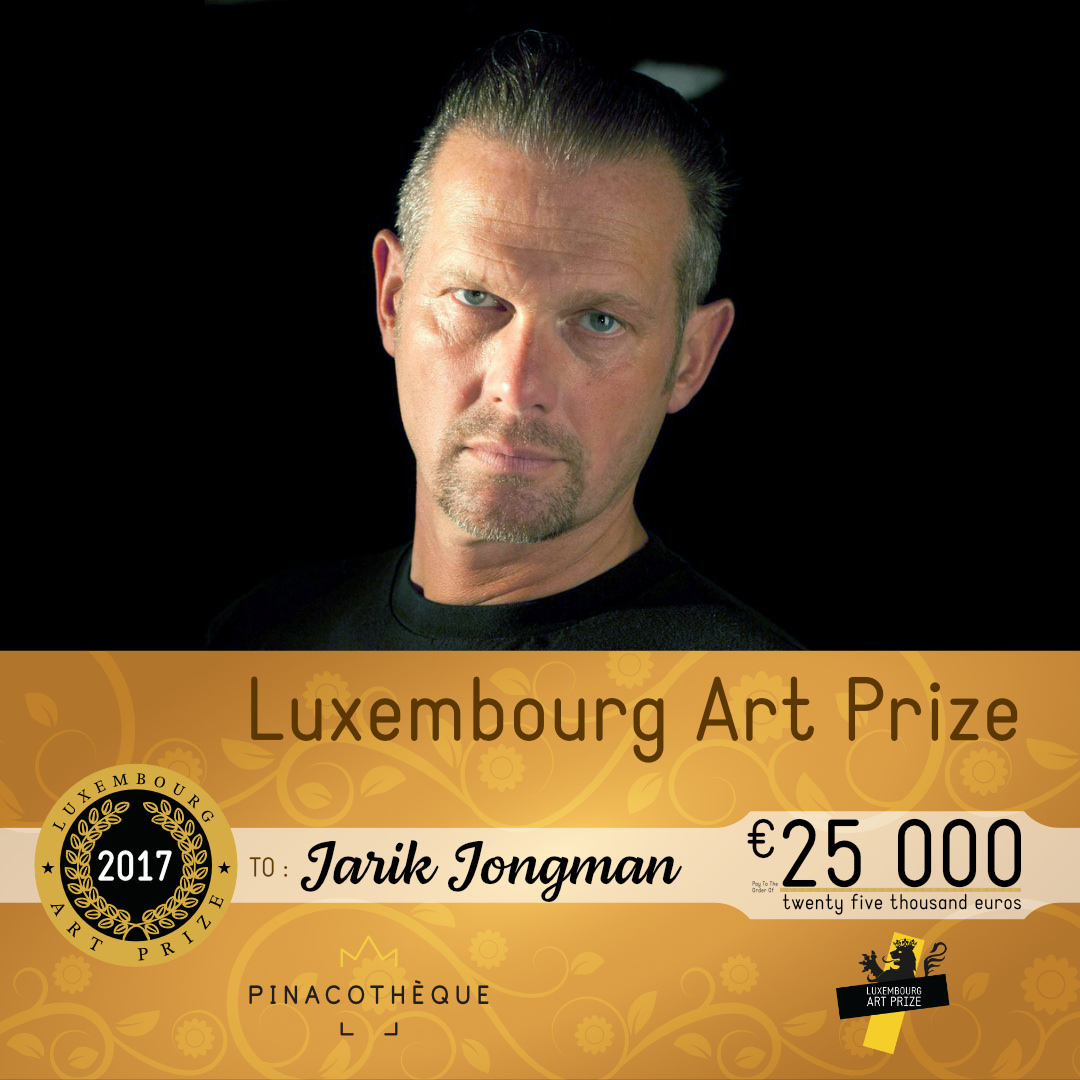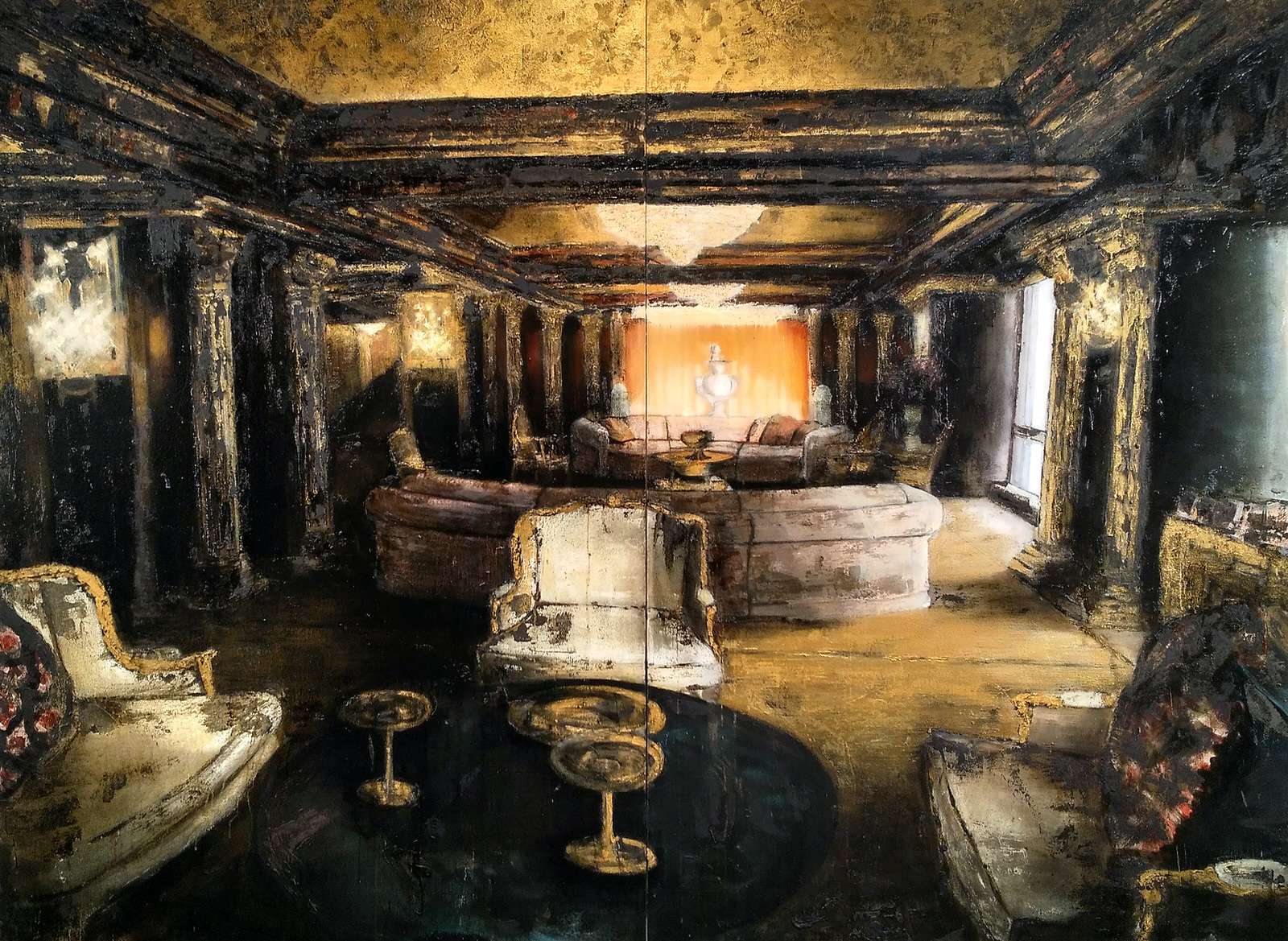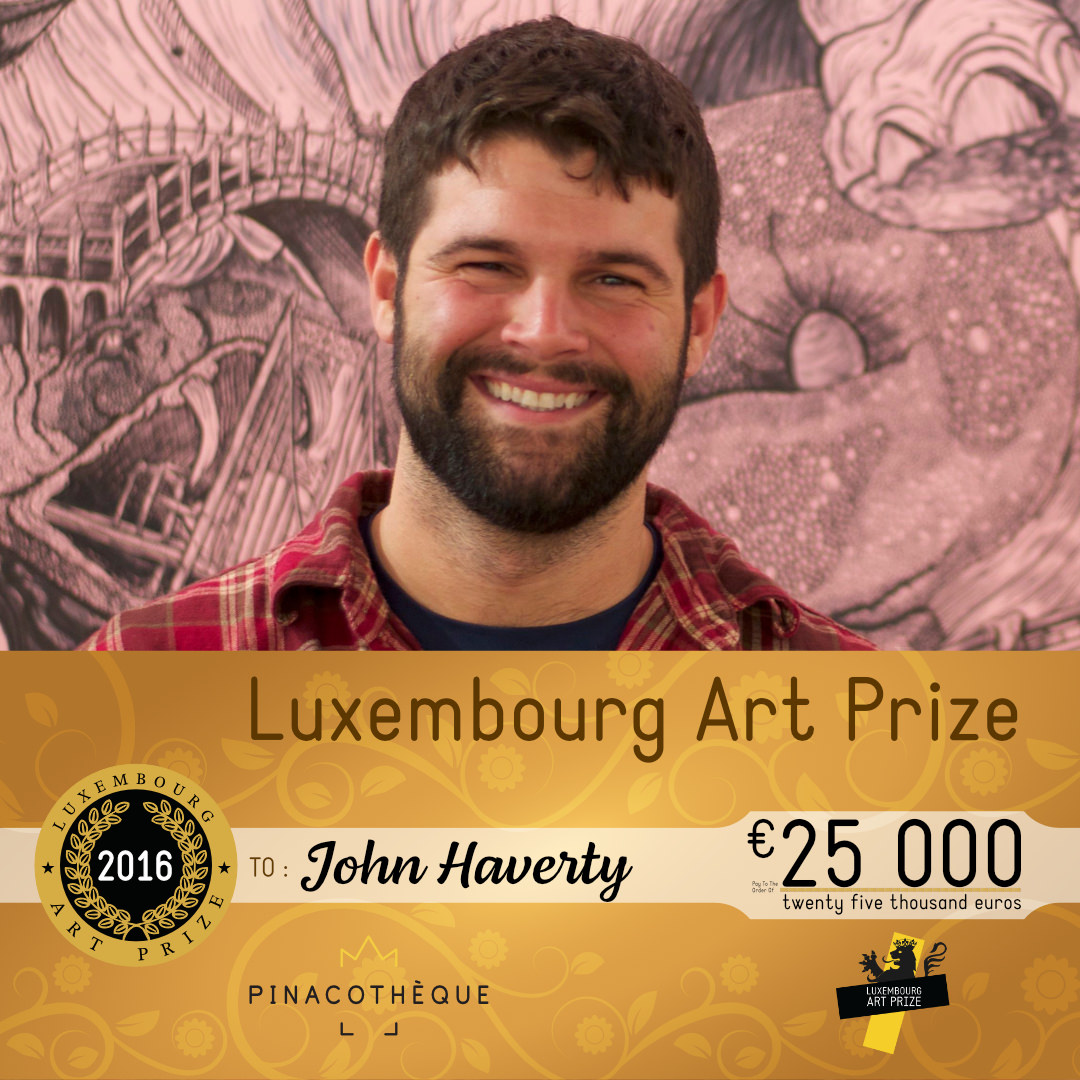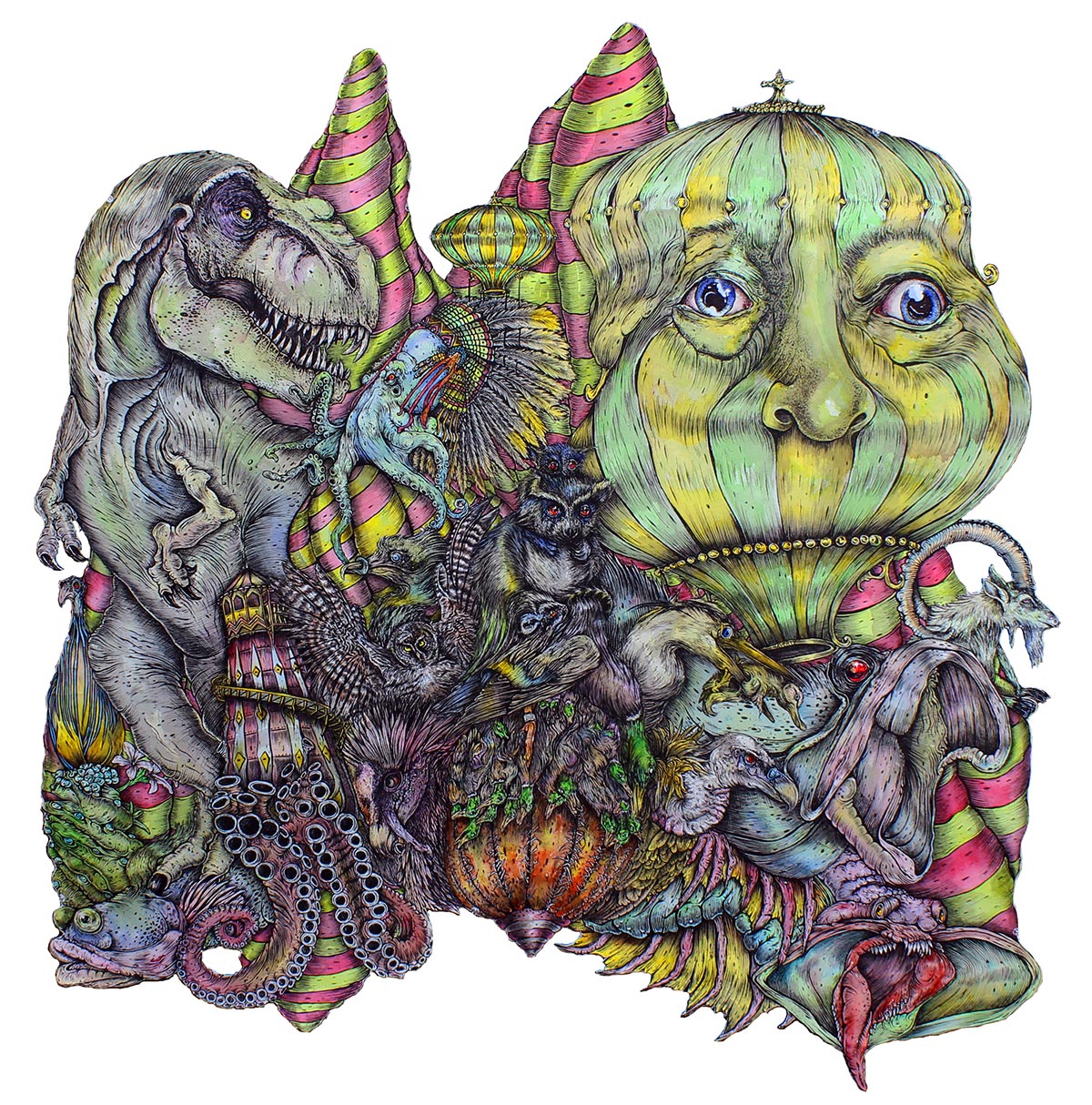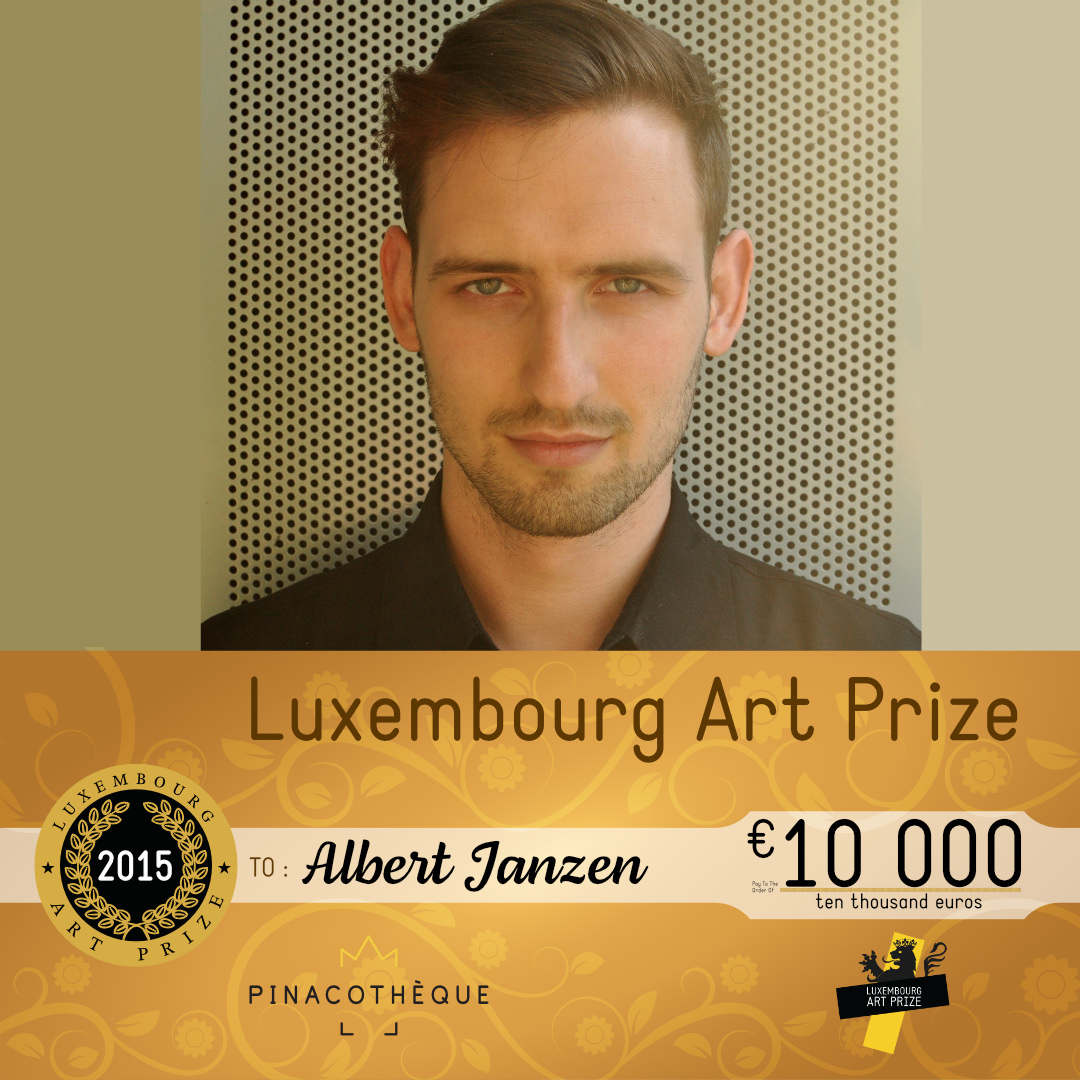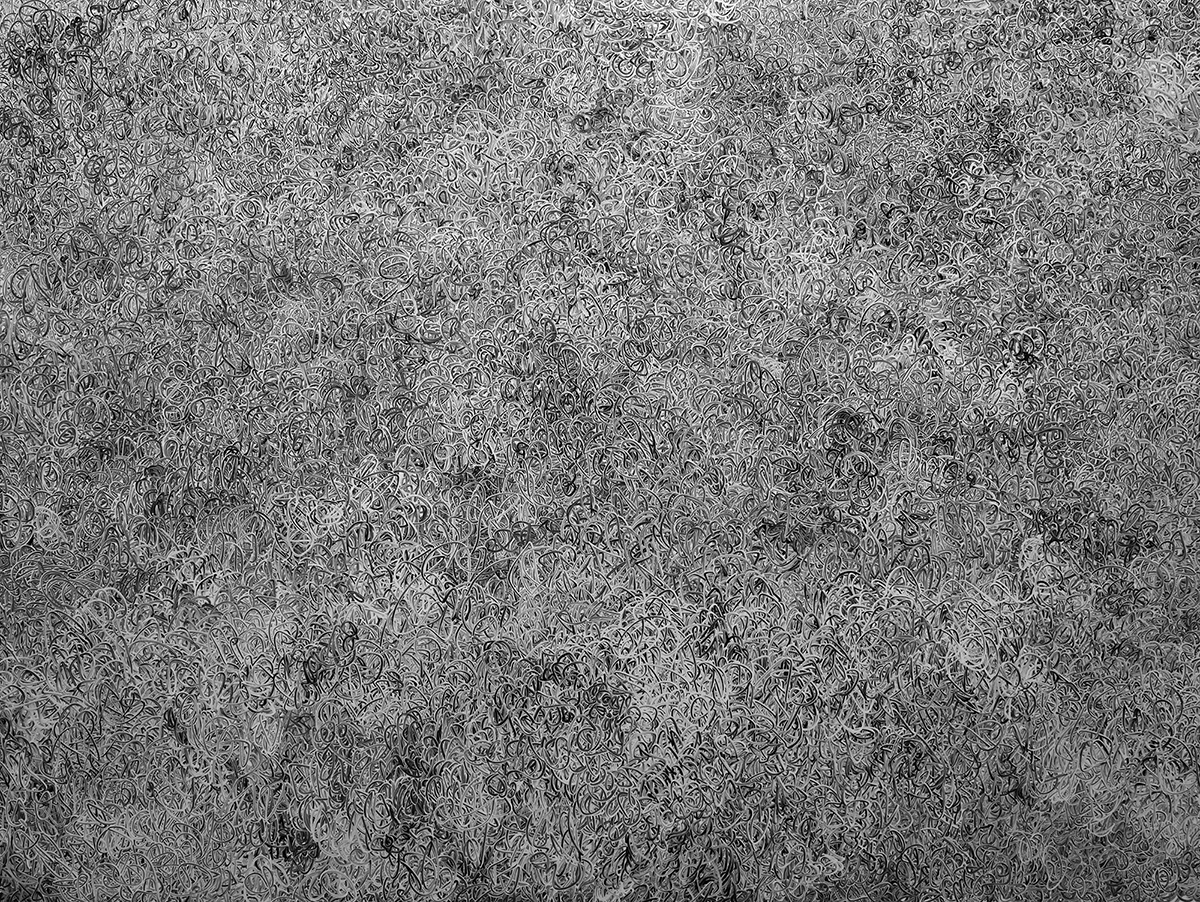Submit your entry now!
Click here
The winners of the Luxembourg Art Prize
Winners of the 2024 Luxembourg Art Prize
The winners of the 10th annual edition of the Luxembourg Art Prize are artists from Germany, Turkey, and Portugal:
1st prize: Azim F. Becker, Germany
2nd prize: Burcu Perçin, Turkey
3rd prize: Stefan Osnowski, Germany & Portugal
Together, the winners share the sum of €35,000 (approximately US$37,000) allocated for the 2024 edition. This amount can be spent as they see fit and is distributed according to their ranking established by the independent jury. They win €20,000, €10,000, and €5,000 respectively.
Azim F. Becker, 1st winner of the Luxembourg Art Prize 2024
▸ Azim F. Becker was born in 1991 in Germany. He is 33 years old in 2024. He lives and works in Osnabrück (Lower Saxony) in Germany.
The artists who inspire him are Erwin Wurm, Marina Abramović, Ron Mueck, Wes Anderson, Thomas Rentmeister and Sam Jinks.
He wins the sum of €20,000 corresponding to the 1st prize, along with congratulations from the museum and jury members. He is free to use this money as he sees fit.
"I work with the intensity of the present moment; my sculptures emerge from reality, though they are timeless and often surreal. Through works like 'Sprout'n Prop', I aim to capture the effort of growth and liberation. As a dark-skinned artist, I question how skin colors influence our perception and whether my works automatically convey a political message. My approach remains open, allowing each viewer to project their own reality. In 'Muckelig (Cozy)', a sculpture in silicone and textile, the ambiguity between comfort and tension invites everyone to explore their own emotions and inner reflections."
Selected Work:
"Cozy", 2024, silicone, textile, 47x60x70 cm (19x24x28 in.)
Description:
I intertwine hyperrealism with a surrealist approach, creating what I call Hypersurrealism. In this symbiotic relationship between different forms of realism, my work focuses on emotional realities. When something feels surreal despite being real, it arouses both suspicion and curiosity. At that precise moment, everyone begins to reflect on their own emotions.
My aim is to embody these emotional realities to open up a wide range of interpretative possibilities and provoke diverse mental effects in viewers. My work, "Cozy," perfectly illustrates this approach. This sculpture features a tight knot of fleece from which two hands emerge. Do the hands appear exhausted or relaxed? Does the knot seem tense or comfortably snug? These questions invite viewers to project their own feelings and interpretations.
Each piece thus becomes an introspective mirror, an opportunity to engage in a dialogue with one's emotions. "Cozy" does not aim to impose a single reading; it is a subjective reflection of the viewer's state of mind. My intention is to provoke personal reactions and create a space for exchange between the work, imagination, and the viewer's sensitivity.
Burcu Perçin, 2nd winner of the Luxembourg Art Prize 2024
▸ Burcu Perçin was born in 1979 in Turkey. She is 45 years old in 2024. She lives and works in Istanbul, Turkey.
The artists who inspire her are Max Beckmann, Anselm Kiefer, Gerhard Richter and Louise Bourgeois.
She wins the sum of €10,000 corresponding to the 2nd prize, along with congratulations from the museum and jury members. She is free to use this money as she sees fit.
"I am interested in social and environmental issues in my work, from abandoned warehouses to marble quarries, emphasizing that it is not only nature that is lost, but also our future. Through my unique aesthetic language, I explore themes of consumption and individual loneliness, created by globalization and the industrial order. My works blend past and present, integrating ancient sculptures into artificial landscapes created by humans. I also work in sculpture and photography, offering a contemporary view of transitional periods between Greek and Roman art, as seen in my painting 'Transition Period,' 2024."
Selected work:
"Transition Period", 2024, Oil on canvas, 145 x 205 cm (57 x 81 in.)
Description:
My painting, entitled Transition Period, explores the influence of transitional periods in Greek and Roman art. I interpret the interactions between the late archaic period and the classical period through contemporary values and imagery. By blending materials from the past, often observed in museums, with representations of today, I seek to create a dialogue between eras.
This work reflects a moment of transition, an intermediate stage between different times, and reminds us that current issues find their roots in our shared history. Through this painting, I express the idea that the cultural and social transformations shaping our present are inseparable from the experiences of past civilizations.
My intention is to weave a timeless connection between the past and the present, where historical layers meet and intertwine. Transition Period is, for me, a celebration of the richness of our collective heritage while reflecting on the changes shaping our current world. It is an invitation to question our history and view the present through the lens of what came before.
Stefan Osnowski, 3rd winner of the Luxembourg Art Prize 2024
▸ Stefan Osnowski was born in 1970 in Germany. He is 54 years old in 2024. He lives and works in Lisbon, Portugal.
The artists who inspire him are Andreas Gursky, Anselm Kiefer, Caspar David Friedrich, Cy Twombly, Gerhard Richter, Gordon Matta-Clark, Hans Hartung, J. M. W. Turner, Joseph Beuys and Richard Serra.
He wins the sum of €5,000 corresponding to the 3rd prize, along with congratulations from the museum and jury members. He is free to use this money as he sees fit.
"I am a visual artist, working primarily on paper using woodblock printing to create an ultra-modern and intricate aesthetic. I am interested in digital codes to express phenomena like time, movement, and space, exploring the convergence of technology and spirituality. My work, “CORDOAMA,” was born from a stay in Portugal, where the raw energy of the waves inspired me. This large Phthalo blue woodcut captures an ephemeral moment of the sea, where time and transformation become tangible. Through this work, I aim to evoke deep introspection in the viewer."
Selected work:
"Cordoama", 2018, oil-based woodcut on paper; hand-printed, 150x315 cm. (59x124 in.)
Description:
The work selected by the Luxembourg Art Prize 2024 has its roots in Portugal, inspired by my stay in Lagos, where I lived and worked in communion with nature, particularly on the Costa Vicentina. Every day, I contemplated the waves crashing against the cliffs, feeling their power and deep vibration. At Praia do Cordoama, a near-death experience facing the ocean transformed my perception of life, profoundly influencing this work.
CORDOAMA is a large-scale monochrome woodcut representing a breaking wave. This image captures the fleeting moment when the sea transforms into an infinite repetition, blurring the boundaries between land, sea, and sky. The work reflects themes such as global warming, water scarcity, and the disappearance of natural landscapes due to human intervention. As one approaches the work, the maritime landscape dissolves into an abstract grid, symbolizing absence and transformation.
Inspired by artists like Caspar David Friedrich or Gerhard Richter, this woodcut evokes solitude and humanity's relationship with nature's immensity. Created by hand using high-pigmentation inks, it reveals a unique depth of phthalo blue, subtly changing according to light and perspective. Signed and numbered as an artist's edition, this piece testifies to water's ability to symbolize life, time, and transformation, capturing an eternal moment of movement and abstraction.
Winners of the 2023 Luxembourg Art Prize
The winners of the 9th edition of the Luxembourg Art Prize are artists from Japan, France, and Germany:
1st prize: Naoko Sekine (直子 関根), Japan
2nd prize: Fred Kleinberg, France
3rd Prize: Ulla Hase, Germany & Belgium
Together, the winners share the sum allocated for the 2023 edition. This amount is €35,000 (approximately US$38,000) to be spent as they wish and distributed according to their ranking established by the independent jury. They win €20,000, €10,000, and €5,000 respectively.
Naoko Sekine (直子 関根), 1st laureate of the Luxembourg Art Prize 2023
▸ Naoko Sekine (直子 関根) was born in 1977 in Tokyo, Japan. She is 46 years old in 2023. She lives and works in Chiba, Japan.
The artists who inspire her include Cy Twombly, Gerhard Richter, James Turrell, Jasper Johns, Mark Rothko, Piet Mondrian, Sol LeWitt, Matsutani Takesada (Gutai member), Kishio Suga (Monoha member), El Anatsui, and Steve Reich.
She wins the sum of €20,000 corresponding to the first prize, along with congratulations from the museum and jury members. She is free to use this money as she sees fit.
"I have thought at length about landscapes, considering them as influential entities rather than mere expanses of space. Our modern world is shaped by humans, filled with intentional images and spaces. Landscapes first arise in the mind, influenced by architecture and lines. They integrate inner and outer elements, connecting consciousness and environment. My artistic creation explores this complex relationship by painting sensory experiences, seeking to expand the meaning of painting through consciousness and structure. My artistic concept draws inspiration from Japanese Bunraku puppetry and the music of Steve Reich, creating networks of independent elements to form an image. This process is also inspired by my visits to prehistoric caves in France. Today, I am in search of more abstract creative motifs, exploring the underlying structure and opening new visual perspectives. My recent work is inspired by New York, where I discovered that urban landscapes can be reduced to lines and colors, evoking hidden richness. My MirrorDrawing series combines painting, gesso, and ceramics to create captivating reflective surfaces that mirror the environment and the viewer's perception. I also plan to explore colored mirror works in the future."
Selected Work:
« Mirror Drawing-Straight Lines and Nostalgia » (« Mirror Drawing - Straight Lines and Nostalgia »), 2022, graphite and gouache on wood, 294.5 x 294.5 cm (116 x 116 inches)
Description:
During my trip to the United States in 2017, I was inspired by the urban landscape of New York and created this work thinking that Mondrian's compositions were actually landscapes. The landscapes of American cities are characterized by straight lines and rational trajectories, creating a sense of linearity, far from the European and Japanese landscapes with their historical layers and conscious depths. This sensation has transformed into reduced and purified elements, reminiscent of Mondrian's works, composed of white surfaces, black lines, and primary colors. Mondrian even included the word "New York" in the title of some of his works, perhaps suggesting a nostalgia for linear elements.
This work consists of nine panels of different sizes, forming physical lines that are also lines in the painting. Memories of Mondrian's paintings and the New York landscape shaped this composition. The lines are drawn with pencil and then polished with ceramics, creating a reflective surface where the environment and the sharp lines of the drawing are reflected. This effect creates a ghostly image that intertwines with the composition.
This piece is part of the MirrorDrawing series. The panels are prepared with gesso, then layers of gouache are applied before adding the pencil drawing. By polishing with ceramics, the surface becomes shiny, reflecting light, viewers, and movements of the environment. Depending on the viewing angle, it can even take on a metallic appearance. Touches of color are present in the work, emerging gradually and blending with the colored reflections and the blur of the image.
I plan to explore further works with colored mirrors in the future.
Fred Kleinberg, 2nd laureate of the Luxembourg Art Prize 2023
▸ Fred Kleinberg was born in 1966 in Paris, France. He is 57 years old in 2023. He lives and works in Paris, France.
The artists who inspire him are Anselm Kiefer, Caravaggio, Diego Velázquez, Francisco Josè de Goya, Georg Baselitz, Miquel Barceló, and Oskar Kokoschka.
He wins the sum of €10,000 corresponding to the 2nd prize, along with the congratulations of the museum and jury members. He is free to use this money as he sees fit.
"For three decades, I have cultivated a figurative art in painting and drawing, exhibited worldwide. Intrigued by social phenomena, I scrutinize the impact of the personal on our condition. My travels nourish my contemplation and creativity, structured in thematic series. "Odyssey" (2016/2017) explores exile and migration, drawing from experiences in refugee camps. "We can be heroes" (2019-2021) questions heroism through a gallery of inspiring portraits. Lastly, "Red situation" (2022/2023) delves into the boundaries between the interior and exterior, shedding light on urbanity and isolation in the context of confinement, with a predominance of red, a color laden with symbolism."
Selected Work:
“Mars”, 2023, oil painting on canvas, 130 x 197 cm (51 x 78 inches)
Description:
The canvas titled "Mars" is an oil painting made in 2023, part of my new series exploring themes of ambiguity and the boundaries between the interior and the exterior. This series features urbanity and isolation in a post-modern meta-narrative, influenced by various aspects related to confinement during the COVID-19 pandemic.
The painting, like the series as a whole, is imbued with the color red, which holds a central place. In the West, red was the first color mastered by humanity, making it an emblematic hue, rich in material, social, artistic, dreamlike, and symbolic terms.
Mars is often nicknamed "the Red Planet" due to its reddish-orange tint in the sky. This color led the ancient Greeks and Romans to name it after their God of War because of its similarity to red, thus establishing a historical and cultural association that endures.
Ulla Hase, 3rd laureate of the Luxembourg Art Prize 2023
▸ Ulla Hase was born in 1966 in Kiel, Germany. She is 57 years old in 2023. She lives and works in Brussels, Belgium.
The artists who inspire her are Agnes Martin and Anni Albers.
She wins the sum of €5,000, corresponding to the 3rd prize, along with congratulations from the museum and jury members. She is free to use this money as she sees fit.
"My artistic work is the result of a fusion of materials, thoughts, and actions, exploring their natures and intensities. Through lines on paper, I connect the past and present, transforming my perception. My art resides in the active gestures and evolving materials, a contemplation that engages the whole body. My selected work, "Untitled" (2019), is an example of this transparent and complex weaving, executed with a Pilot G-2 pen on satin-finish Arches paper, framed in wood and painted white."
"Untitled", 2019, Pilot blue roller pen G-2 on Arches satiné, 114.5 x 125.7 cm (45 x 50 in).
Winners of the 2022 Luxembourg Art Prize
The laureates of the 8th edition of the Luxembourg Art Prize are from France, Turkey, Germany, and Spain:
1st place winner: Ilann Vogt, France
2nd place winner: Sema Maskili, Turkey
3rd place winner: Evelyn Hellenschmidt, Germany & Spain
Together, the 3 winners will share the €80,000 (approximately $83,000) allotted for the 2022 edition. The 1st place winner will receive €50,000, the 2nd place winner €20,000, and the 3rd place winner €10,000. The artists are free to spend this prize money however they wish.
Ilann Vogt (France), 1st place winner of the 2022 Luxembourg Art Prize
▸ Ilann Vogt was born in Quimper, France in 1986. He’s 36 years old in 2022 and lives and works in Cancale, France.
Artists who inspire him include Anselm Kiefer, Roman Opałka, Anni Albers, El Anatsui, Pénélope d'Ithaque and J L Borges.
He wins a total of €50,000 for 1st place. Congratulations on behalf of the museum and members of the jury. He is free to use the money as he sees fit.
“Day after day, I assemble texts cut into strips to make paper weavings of all sizes, according to the length of the woven work. From Arthur Rimbaud’s ‘Eternity’ to Marcel Proust’s ‘In Search of Lost Time’ and Homer’s ‘Odyssey’ or Franz Kafka’s ‘The Metamorphosis’, my productions cover the history of world literature to compose an ideal and humanistic world library where the text goes with the image. In an artisanal, almost monastic way, I work with books in the solitude of my studio to transform them into canvases of characters that have become abstract and yet are directly accessible.
Inhabited by the myth of Penelope from the Dogo moires and cosmogonies, I work by hand, thread by thread, on the emergence of a texture, of a subject that would be a narrative, time and view, with the awareness that a work of art is, above all, the work of a life and that I could produce as many works as there are books, tirelessly multiplying the tracks of the imagination.”
Selected work:
“Eloge au récit” (In Praise of Storytelling), 2021. Cut and woven paper, 650 x 950 cm (256 x 374 in.)
Description:
“In the work presented, I no longer just take the entirety of a text and, as such, I break with the unity of “one text, one work”. I only use extracts of text, in all possible languages, and I interweave them and bind them to create a weaving that reflects past and present civilizations. With this monumental piece, I almost reach the dimensions of Paul Véronèse’s painting ‘The Wedding at Cana’, painted in 1563 and displayed in the Louvre in Paris.”
Sema Maskili (Turkey), 2nd place winner of the 2022 Luxembourg Art Prize
▸ Sema Maskili was born in 1980 in the city of Edirne in Turkey. She turned 42 in 2022. She lives and works in Istanbul.
Sema is inspired by Francis Bacon, Lucian Freud, Max Ernst, and Michelangelo Buonarroti.
On behalf of the museum and the independent jury, congratulations to Sema on her 2nd place prize of €20,000. She is free to use the money however she sees fit.
“My works make reference to the concept of a primitive and barbaric human nature. There is an aggressive need that continues to exist somewhere within a person, despite being civilized.
When I paint a human being, I concentrate on the violence within them, and I create compositions made from bodies that clash in an animalistic way, intertwined anatomical structures and crushed and deformed body parts.
I approach humans as an entity caught between ethical values and animal instincts, and I question the complexity of human nature.
In some of my paintings, I seek to depict these bodies as beings thrown into an unknown world. I put them into spaces that I call metaphysical and, in parallel, I attempt to bring a new approach to the space.
In 2017, I began a series of paintings that I called ‘Power Creates Monsters’. The starting point of this series is based on the idea that one entity does not accept a second entity.
While producing, thinking and reading about it, at one point, I came across Nietzsche's writings on the ‘Will to Power’. I still question what power is, and I continue to produce artworks around this concept.”
Selected work:
“Mob Psychology”, 2022. Oil on canvas. 110 x 85 cm. (43 x 34 in.)
Description:
“In this painting, I focused on our instinctive reactions which are exacerbated by a mob mentality, along with the phenomenon of a gang mentality, which has existed throughout human history and still persists, sometimes causing unjustified deaths in underdeveloped communities.
It’s a work that speaks against the oppression of the minority by the majority in addition to all sorts of sectarian ideas.”
Evelyn Hellenschmidt (Germany & Spain), 3rd place winner of the 2022 Luxembourg Art Prize
▹ Evelyn Hellenschmidt was born in 1962 in the town of Eltville in Germany. She turned 60 in 2022. She lives and works near Madrid.
Evelyn is inspired by Caspar David Friedrich, Rembrandt Harmenszoon van Rijn, Gaspar-Pieter Verbruggen El Viejo, Cristian Coclers, and Willem Garbon.
On behalf of the museum and the independent jury, congratulations to Evelyn on her 3rd place prize of €10,000. She is free to use the money however she sees fit.
“I first encountered the world of sculpture as a child in my grandfather Emil Franke’s studio. My works are unorthodox. I learned on the street. At a very early age, I started spending time in the studios of other artists, ceramists, and sculptors. For a year, I worked in a forge and learned how to weld in a foundry in Madrid. I then went on to study at the International School of Photography and Film (EFTI), which is also in Madrid. In 2011, when I was 49, I received a grant from the Pollock-Krasner Foundation in the United States.
My work is an expression of intimacy, meticulousness, egotism, and reverie. I’m constantly looking for minimalist structures, effortless patterns, and geometric purity. I like to explore the circular nature of existence and our need for familiarity, and combine the two to create unique and authentic depictions.”
Selected work:
“Barcas de posibilidades o barcas del hambre” (“Boats of possibilities, boats of hunger”), 2008. Sculpture in brass, copper, and welded and patinated bronze. Variable dimensions.
Description:
“This work is an installation inspired by illegal immigration from Morocco to Spain. The title refers to the tragic situation of people who have to cross the border between the two countries by sea for a chance at a life without hunger and shortages. Sometimes these people spend months or even years waiting in a sort of no man's land, often in inhumane conditions, to enter the “promised land.” Few succeed and many die trying or are sent back to their place of origin.
I lived on the coast of Cadiz in southern Spain, where on bad days dozens of shipwrecked boats are taken to shipyards full of African boats. This installation is an illustration of how wealth is dependent upon where we are born.”
The 3 laureates of the 2021 Luxembourg Art Prize are...
The winning artists for the 7th edition of the Luxembourg Art Prize are from Brazil, Canada, and Lithuania:
1st place winner: Celina Portella, Brazil
2nd place winner: Francis O'Shaughnessy, Canada
3rd place winner: Laisvydė Šalčiūtė, Lithuania
Together, the 3 winners will share €80,000 (approximately $100,000) in accordance with their ranking established by the independent jury. The 1st place winner will receive €50,000, the 2nd place winner €20,000, and the 3rd place winner €10,000. The artists are free to spend this prize money however they wish.
Celina Portella (Brazil), 1st place winner of the 2021 Luxembourg Art Prize
▸ Celina Portella, 44 years of age, was born in 1977 in Rio de Janeiro, Brazil. She lives and works in Rio de Janeiro.
Celina gets her inspiration from the following artists: Andrea Fraser, Erwin Wurm, Helena Almeida, Yvonne Rainer, Ana Linnemann, Lenora de Barros, Carmela Gross, Trisha Brown, Liliana Porter, Rebecca Horn, Fischli & Weiss, Robert Morris, Richard Sierra, and Dennis Oppenheim.
On behalf of the museum and the independent jury, congratulations to Celia on her 1st place prize of €50,000. She is free to use the money however she sees fit.
“I am especially interested in interdisciplinary research on bodies, images, and movement. My work combines elements from photography and video and is presented on a variety of different materials. For the past few years, I have been creating installations and works that invite viewers to contemplate the representation of the human body and its relationship to space. My work incorporates several domains simultaneously, including dance, performance art, architecture, cinema, and more recently, sculpture.
As a former professional dancer and dance producer, my work is also deeply rooted in the world of choreography. In fact, it was during my time as a dancer that my interest in the movements of the body (and the difficulties with its representation) was born.
After making my first videos, I focused on the projection of life-sized bodies and the superposition of images, incorporating architectural structures into my work. These projections helped me fine-tune my use of videos and images and explore new technologies and mediums.
I then began to create a series of works where the body interacts with the borders of its frame, incorporating objects or sculptures to make the (initially) virtual field material. By creating installations where bodies interact with the medium, I allow for photography and video to become structural elements of the work itself, for art to become one with its medium.
The main focus of my work is to explore the boundary between virtual reality and bodily movements, in an attempt to blur the lines and confound the material world with the world of fiction. By blatantly using trompe l'oeil with artistic mediums, I create an ambiguous field between the material and the immaterial, between the objectivity of the world and illusion.”
Selected work:
“Corte/1” (Cut/1), 2019, Cut-out photography, 135 x 95 cm (53 x 37 in.)
Description:
“In the work “Corte/1,” the paper upon which the photograph is printed is cut physically such that the actual cut matches the action depicted in the image. “Corte/1” is part of a series in which I make the action represented in the images of the various mediums (photography, video, canvas) material. My body, interacting with the image, cuts the paper that makes it material, modifying the representation of myself and creating a link between the image and the material.”
Francis O'Shaughnessy (Canada), 2nd place winner of the 2021 Luxembourg Art Prize
▸ Francis O'Shaughnessy, 41 years of age, was born in 1980 in the city of Levis in Quebec, Canada.
Francis gets his inspiration from the following artists: Sally Mann, Alex Timmermans, and Borut Peterlin.
On behalf of the museum and the independent jury, congratulations to Francis on his 2nd place prize of €20,000. He is free to use the money however he sees fit.
“Since the start of COVID-19, it has been difficult to continue with my photography as I have been unable to invite models to the studio. I therefore came up with the idea of setting up a bellows in front of a computer to convert unpublished digital images into wet plate collodion photographs. I wanted to revisit some previous works and “recontextualize” or reinterpret my favorites. By doing so, I discovered a technique combining ancient processes with modern technology. And the result was so interesting that I decided to make a series.
Unlike digital photography, the wet collodion process was one of the original photographic techniques (it was introduced in 1851). The first step involves making a yellowish syrup called “wet collodion.” Next, I coat an aluminum plate with the syrup and insert the plate into a bellows before taking a picture. A variety of chemicals are used to obtain the negative then positive image on the plate. I varnish the aluminum plate to keep the print intact for a century. Finally, I digitize the plate to make large-format prints on paper.
With this traditional medium, I raise questions regarding the material of the image by highlighting mistakes, accidents, imperfections, and blurred details. What I love about this medium is its entirely hands-on nature. For me, the artistic process must stimulate the senses. In other words, I prefer the human side over the immaterial and digital (i.e., doing post-production work on my computer). My darkroom is my retouching software – in this respect, I’m heading in the opposite direction than most modern artists who are becoming increasingly dependent upon their computers. I like to think of myself as part of the ancient artistic avant-garde, a movement consisting of contemporary photographers who reject current technological processes and methods.
There’s no decisive moment with wet collodion – there’s only time. It’s about reaching a “slow photography” speed, one that captures durations instead of moments. The recording of time becomes visible via the collodion which gradually flows and dries on the plate. Slow photography is about reducing the speed of the process to a pace we can really appreciate at a time when everything passes us by in an instant.”
Selected work:
“Plate 58,” 2020 - Wet plate collodion photography
Description:
“Since 2021, I’ve been embracing the trial and error process in my work. I have experimented (with varying degrees of success) with more than 160 wet collodion plates to finally learn how to enhance the formal textures in my creations. In some places, these textures resemble paintings, maintaining an aspect that is somewhat detached from reality. With this work, which arose during COVID-19, my goal was not to recapture the essence of (neo)pictorialism, but to use photographs to develop an idea of (without copying) contemporary painting. I use productions that promote the madness and mistakes of the artist to obtain exploded views and leave a lasting visual impression on the viewer.”
Laisvydė Šalčiūtė (Lithuania), 3rd place winner of the 2021 Luxembourg Art Prize
▸ Laisvydė Šalčiūtė, 57 years of age, was born in 1964 in Lithuania.
Laisvydė gets her inspiration from the following artists: Barbara Kruger, Grayson Perry, John Baldessari, Louise Bourgeois, Neo Rauch, Marcel Dzama, and Hernan Bas.
On behalf of the museum and the independent jury, congratulations to Laisvydė on her 3rd place prize of €10,000. She is free to use the money however she sees fit.
“The works I submitted for the Luxembourg Art Prize are part of my series on “Melusine's Paradise.” They are a provocative and amusing visual story for adults inspired by Bayesian statistics. Bayesian statistics are based on a theorem which determines the probability that we are only in possession of part of the information when we observe a particular situation. Bayes' theorem provided the basis for the creation of an “anti-spam” computer program.
Few would dispute that paradise is the happiest and most environmentally friendly place to be, and that “spam” is just a waste product that contributes to today’s “information pollution.” Spam is not environmentally friendly. In our daily lives, we are constantly bombarded by digital information and images that “tell stories,” turn ideas into images, create confusion, and dilute facts ad nauseum, all the while trying to evoke an emotion or reaction. I see this flow of information and images as ecologically unsound – and therefore try to oppose it. I have developed an “eco-friendly” creative approach: I collect images that interest me and random texts from the Internet, recycle them (like plastic bottles), and rewrite them, using paradox to change their meaning and context. Then I use them again to create an all-new work, a visual fairy tale for adults that presents our reality as it is constructed by the representation. Tales and stories are mediums themselves. Since the dawn of time, humans have expressed their tangible and spiritual experiences through the universal language of storytelling. This is what I wish to achieve with my work. Melusine, my fictional anti-heroine, is the main character of my work. With irony and metaphor, she voices her opinions on the social relationships and statuses of modern life (upon which she also depends), as well as on the theatrical discombobulation of our consumer society and the tragicomic idiocy that emerges from it, motivated by the search for the greatest value of all: a “happy life.”
Selected work:
“The Rape of Europe,” 2019, woodcut, oil and acrylic on canvas, 159 x 159 cm (63 x 63 in.)
Description:
“The character with the illuminating eyes and nimbus – is a character created by me and it is inspired by a Melusine (Melusine (French: [melyzin]) or Melusina, a figure of European folklore and mythology and it is a repetitive character traveling through all my resent works. The making process (the technique) for these works starts from a wood carving, which is transferred on canvas by using spoon to finely scrub the oil paint by hand from the 'drawing’ to canvas. After the canvas dries – I paint by hand on it. Documentary video about the process: https://youtu.be/wC2iAaOGiVs
This particular series of works with Melusine was created when I was invited by Palazzo Ducale di Mantova (IT) museum for the exhibition 'Coming Out' with Italian sculptor Gehard Demetz in 2019. My choice of the artworks media for the exhibition in Museo Palazzo Ducale was not accidental – the media I use, is time-consuming and required hard handwork and patience. This choice is already a part of a dialogue with the artists' who commissioned their works for the owners of the palace in ancient times and with the sculptor Gerhard Demetz. The works I‘ve created by thinking about this particular exposition talk about emotions. They are (self) ironical. Body is needed for the feelings. That's why I used my own hands as a tool to create, because they are closely related to the brain, where the feelings lie. I engraved the wood by hands, because the tree also has a body that has feelings, the tree has a story – it grows, it blooms, a lot of things happening around it no matter where it grows and then, somebody just cuts it. I kind of extend its story further by engraving it and after, by painting on canvas new stories about the feelings of modern people.”
Lionel Sabatté, winner of the 2020 Luxembourg Art Prize
▸ Lionel Sabatté was born in Toulouse (France) in 1975. He lives and works in Paris (France) and Los Angeles (California, USA).
The artists who inspire him are Alberto Giacometti, Pierre Soulages, Thomas Houseago and Paul Rebeyrolle.
He has won the sum of €50,000 to be paid into his bank account, and congratulations from the museum and the members of the jury. He is free to use this money as he sees fit.
The realm of the living as well as the transformations of matter due to the passage of time lie at the heart of the artist's work. For several years, he has been collecting materials that carry with them the trace of lived experience--dust, ash, charcoal, dead skin, tree stumps, and so on. These elements are unexpectedly combined and the works thus created carry within them both a delicacy and a "disturbing strangeness", thus giving life to a hybrid bestiary in which creatures from the abyssal depths rub shoulders with small birds from oxidized islands, bears, wolves, emus, and owls, as well as unicorns and more.
Simultaneously a painter, a drawer and a sculptor, Lionel Sabatté tries to make all of his works dialogue in permanent interconnection. In short, his work on the mineral, the animal, and the organic gives rise to poetic, sensitive, troubling works that participate in a global reflection on our condition and the place we occupy in our environment.
“Sabatté's activist recycling is not just about ecological and environmental concerns. We can risk a saving "leap". This recycling testifies, perhaps, to the interplay of worries about the survival of the living, and to the expectation of a jolt to the hoped-for escape from an implacable existential condition that is now unformulable in the simply "humanist terms" of the post-war period. Collecting "dust sheep" at the Châtelet metro station in Paris, regluing dead skin from pedicures together so as to graft them to scrap metal, wood, cement, and dead trees, recalls the ragpickers of yesteryear and the way children and women comb through the piles and mountains of rubbish in the wild dumps of Africa and Asia for material to consume, trade, and sell in order to survive. The ragpicker mentioned by Baudelaire--that "most provocative figure of human misery" according to Benjamin--is a figure who collects everything: "old papers, corks, bones, cardboard trimmings, nails, broken glass, the dead cats and dogs that have been thrown on the public highway in violation of ordinances, hair--in a word, anything that can be sold." In the heaps of garbage, the rubbish, the residue, the refuse, Victor Hugo detected "the meadow in bloom", the green grass, life. Sabatté's works run through all these registers and make us hear, as an echo, the following note by Benjamin comparing the writer Siegfried Kracauer to this figure of the Lumpenproletariat ("proletariat in rags"): "A ragpicker, in the early morning--in the dawn of the day of the revolution”. This is how we have to view such a back-and-forth between nature and culture which moves away from all the thought on this central theme of Western thought while simultaneously agreeing to approach it.”— Bernard Ceysson, 2019.
Selected work:
“Red fortune and sub cutaneous,” 2019 – Oil on canvas. 130 x 130 cm (51 x 51 in.)
Description:
“My oil and acrylic canvases open a dialogue with the other mediums within which my plastic universe unfolds all its richness. I use colors that have melted into one another and I attach paramount importance to the aqueous dimension that gives the work its organic, mineral aspect. Using vivid, contrasting touches, I echo the traces of time, perpetual natural changes and the movement inherent in all life. While patterns can emerge from these mystical paintings, which approach an aesthetic of chaos (in Greek mythology, "Chaos" is a primordial entity from which the universe is born), the imagination is left free for the spectator to discern something in each canvas--sometimes an eye, sometimes a bird, a jellyfish, a landscape seen from the sky, or even the sky itself. »
Jenny Ymker
Winner of the 2019 Luxembourg Art Prize
▸ Jenny Ymker was born in 1969 in the Netherlands. She is 50 years old. She lives in Tilburg (Netherlands).
The artists who inspire her include Cindy Sherman, Francesca Woodman, Grayson Perry and Louise Bourgeois.
This was her third submission to the Luxembourg Art Prize.
She has won the sum of €50,000 to be paid into his bank account, and congratulations from the museum and the members of the jury. She is free to use this money as he sees fit.
"The world of the imagination can feel more like reality than reality itself"
Since 2013 my work has consisted of photos that I have woven into Gobelins.
Originally, the term ‘Gobelin’ could only be used for tapestries that were woven in the ‘Manufacture des Gobelins’ in Paris. Nowadays it is used as a general reference to woven tapestries. I use the term Gobelin because I like the sound of the word, but particularly because it refers to history.
Originally, Gobelins were intended as insulation for the cold inner walls of castles. But at a very early stage, the ornamental function of these tapestries became very important too. Traditionally, stories are depicted on Gobelins. I use the modern form of this ancient weaving technique to represent today’s stories.
In my work I depict situations with the intention of evoking stories in the spectators. I always try not to be too literal, so spectators have space to discover their own stories. I find evoking stories important because I think our ability to tell them is an essential part of our being. I worked in health care for a while. There, it became clear to me that if a person is no longer able to tell about an event, however small, this person will gradually loose his or her feeling of significance, of ‘mattering’.
When I have an idea for a new work I try to find a suitable location and the right clothes, shoes and props.
On site, I stage the entire situation and then make photos using a self-timer or assistant.
One theme in the work is alienation. I consciously choose dresses, bags, shoes from the past. With these, I want to reinforce the feeling of alienation from the environment.
This also informed my decision to have the photo woven instead of printed.
My works are in a way personal performances which I register in Photographs.
In all my works I am the model myself. Of course this is practical because I am always available. But for me, it is also an essential part of the making process, to create a certain ‘world’ and be part of that world myself at that moment, to be in that situation for a moment.
When I have a good photo, I have it turned into a weaving pattern. Together with the weaver I choose the right colours of wool and cotton. Next, a couple of samples are woven. In the basis of these samples I can still make changes and adjustments, after which the definitive Gobelin is woven.
Depending on the image I determine if the Gobelin must be woven in colour or in black/grey/white. In some Gobelins I then embroider parts of the image to emphasize certain parts that support the theme.
The Gobelin weaving technique and embroidery appeal to me because I love the maze of coloured threads that together form an image.
I use the attractiveness of the material to move spectators closer until they see that it is not always pretty what I depict.
"Vervlogen (Bygone)", 2018, tapestry woven in the Gobelins style, wool and cotton, 193 x 291 cm (76 x 114 in.)
Description:
"This tapestry talks about letting go."
Ludovic Thiriez
Winner of the 2018 Luxembourg Art Prize
▸ Ludovic Thiriez was born in 1984 in France. He lives in Hungary with his wife and children.
The artists who inspire him include Adrian Ghenie, Albert Oehlen, Cecily Brown, Gerhard Richter, Marlene Dumas, Maurizio Cattelan, Michael Borremans, Neo Rauch, and Peter Doig.
This was his first time participating in the Luxembourg Art Prize.
He has won the sum of €25,000 to be paid into his bank account, and congratulations from the museum and the members of the jury. He is free to use this money as he sees fit.
His artistic approach:
Life is an accumulation of experiences and feelings. It was by starting from this idea that I found a process of creation in my painting. The idea is to superimpose different elements and styles to create a new balance.
I spent my childhood dreaming. My parents always told me that my head was in the clouds. Today, with a certain distance, I am able to draw on the imagination of my childhood and stories. My inspiration often comes from old photos or from my own shots.
It is not unusual for me to use embroidery and animals in my paintings. The embroidery evokes the transmission of knowledge between generations. In Hungary, where I am based, each region had its own patterns and styles. The quality of the embroidery present in any given house highlighted the skills and know-how of the woman living there. This know-how was passed from mother to daughter.
Animals are part of the imaginary world of children and are very present in fairytales. I use them as narrative symbols for my own stories; sometimes they become characters in their own right.
Childhood is a fabulous mirror for humanity where we find gentleness, play, violence, tenderness, vice, questions, love, etc. A raw material that time shapes. The child slowly becomes aware of his Humanity with great purity and naivety. It is this moment that I try to capture in my work and my research. I observe this transition, choose my moments, and relocate my subjects to transcribe a sensation. Michael Borremans, a contemporary painter I admire, said about one of his exhibitions that the less explanation a painting needs, the better it is. When I "install" different elements on a canvas, I always try to keep this idea in mind. It is both very difficult and exciting to create, to figure out when the story must stop and when it should continue. Sometimes my paintings fill up naturally and sometimes they remain very spare, depending on the feeling that emerges as I paint.
"Le garçon du voisinage" ("The boy from the neighborhood"), Acrylic, ink, oil on linen, 140 x 170 cm
Description:
We see a group of children smiling and having fun, laughing. There is also this one little boy who is treated in a more abstract way—"the neighbor." He looks more worried and on his guard. Another child points to something outside the canvas, something that may also have scared the birds. And then this yellow line, a sketch, a temporary geometric construction, which stands in the middle of the swamp as if in a dream that escapes our grasp, shifting to become something else.
Jarik Jongman
Winner of the 2017 Luxembourg Art Prize
▸ Jarik Jongman was born in 1962 in Amsterdam in the Netherlands. He lives and works in Amsterdam. The artists who inspire him are Adrian Ghenie, Anselm Kiefer and Peter Doig. He works as a waiter.
Second entry to the Luxembourg Art Prize (2016, 2017)
He has won the sum of €25,000 to be paid into his bank account, and congratulations from the museum and the members of the jury. He is free to use this money as he sees fit.
In his work over the years, the artist has been fascinated by the notions of fleetingness, ontology, religion and history. Many of his works involve architecture in one form or another: motel rooms, waiting rooms and dilapidated buildings, often lacking any human presence, frequently evoking feelings of nostalgia and contemplation, with a definite touch of the miraculous or the supernatural.
In his latest work, conceived especially for the Luxembourg Art Prize, he concentrates on what he sees as the primary tragic development of our time. As with all paradigm shifts, the foundations were laid several decades ago and we are watching the unfolding events with an increasing sense of helplessness.
Socio-economic pressure, immigration, the refugee crisis, international terrorism and climate change are causing anxiety at global level. Underlying the feeling of fear and lack of control provoked by these problems, our post-truth society is emerging, incarnated like nothing else by Donald Trump, the President of the United States of America.
The artist has used modernism, or more specifically modernist architecture, as a starting point for the idea that it represented a utopian spirit, conveying ideal visions of human life and society and a belief in progress. Modernism was very preoccupied with reconciling a new architectural form with social reform, creating a more open and transparent society that believes in human perfectibility in a world without God.
The rise to power of Joseph Stalin led the Soviet government to reject modernism for what it claimed was its elitism. The Nazi government in Germany saw modernism as narcissistic and absurd, together with "the Jews" and "the Negroes". The Nazis exhibited modernist paintings alongside works by mentally ill patients in an exhibition entitled "Degenerate Art". Accusations of "formalism" could end a career, or worse. This is why many modernists in the post-war generation considered themselves the most important bulwark against totalitarianism, the "canary in the coalmine".
The paintings presented by the artist to the Luxembourg Art Prize explore these ideas. The goal is to convey a feeling of imminence, and fire plays an important role. Fire is the ancient symbol of transformation, a metaphysical constant in the world.
He paints these buildings and villas whose significance has been enlarged, moving from simple functionality to an iconic, symbolic status, as sublime, transcendental structures, coveted and threatened by impenetrable, menacing forces.
The feeling of menace is palpable; impenetrable, threatening forces invade this symbol of modernity and illumination.
"It’s Gonna be Great, it’s Gonna be Fantastic" - 2017 - Oil on panels - 180 x 244 cm
John Haverty
Winner of the 2016 Luxembourg Art Prize
▸ John Haverty was born in 1986 in Boston, USA. He is American and lives in Massachusetts, USA. The artists who inspire him are Dieric Bouts, Hieronymus Bosch and Salvador Dali. He works for an airline.
He has won the sum of €25,000 to be paid into his bank account, and congratulations from the museum and the members of the jury. He is free to use this money as he sees fit.
Similar to shamanism, the painting of John Haverty bears within it a highly visible introspective force. “Each painting is a personal journey for me”. Attached to the retro albums of the 1960s-80s and to skateboard and hot-rod culture, the artist combines his interests with his travel, “but I prefer everyone to look at my art for themselves, develop their own opinion and bring their own imagery to my work.”
Whimsical, strange, magical, beautiful or ugly, it all depends. As John Haverty explains, “I get lost when I work. I’m like a curious child in a land of psychedelic wonders.” His pens can spend hours on details and lines that hypnotise him. Each line or dot is important to him, making his work a complex painting. But the idea guiding him is rarely complete: “Every day is different. The creative process is full of unknowns. As every day is different, every mood is different.” Later, contemplating the finished piece, he returns to the feelings and thoughts that passed through him during the journey. “I have photos that show the reality of my past. But my paintings show the feelings of my past.”
That’s how his monumental project Gangrene emerged, a giant painting begun in 2013. “My art, like the infection, is a collage that continues to grow organically. Gangrene presents an ambiguous visual feast that sheds light on problems vexing society…”
Gangrene is a visually violent work that grips the eye. Most of the paintings making up the fresco were created in the artist’s twenties, an unsettling period full of frustration for many people, and his paintings radiate many of his feelings. But John Haverty does not consider himself an angry person. The reasons for this violence lie elsewhere: “As a teenager, I watched a lot of horror films. The thrill of being terrified and a love of the classic monsters are mixed with my journeys, and influence me a lot. My beach house in Cape Cod is pretty sinister, and sometimes I feel as if I am in the presence of spirits. I think all that interests me in a way.”
With his monumental work, the painter produces immersive works that draw the viewer in both psychologically and physically. “I find it hard to explain my paintings in words. For me, the interest is visual. My goal is to grab the viewer’s attention for more than a few seconds.”
“Circus“, 2015, “Gangrene” series, ink and watercolour on paper, 120 x 120 cm, unique
Albert Janzen
Winner of the 2015 Luxembourg Art Prize
▹ Albert Janzen was born in 1989 in Sibirskij, Russia. He is 26. German by nationality, he lives in Amsterdam in the Netherlands. The artists who inspire him include Gerhard Richter, Cy Twombly, Zao Wou-Ki and Antonio Murado.
He has won the sum of €10,000 to be paid into his bank account, and congratulations from the museum and the members of the jury. He is free to use this money as he sees fit.
I examine the fundamental aspects of images, i.e. line. Line is the most intuitive means of perceiving and understanding our environment. Recognising visual structures depends on the recognition of line. This dependence is due to the absolute simplicity of lines. They are so simple that nothing can be conceived of without them. Everything can be constructed with lines, but nothing constructs lines. The only candidate for a structure underlying line is the point. As points are important elements in my drawings, I consider them as fundamental in the same way. The extreme simplicity of line provides an independent aesthetic. It does not represent an idea, as it is constructed from nothing other than itself. To reveal its aesthetic power, line has to be its own system of reference. I draw lines not to construct something, but just to draw lines. The shapes and motifs that emerge in my drawings have no other intention than to reveal the movements of lines. Looking at my lines, one is confronted with an independent entity.
